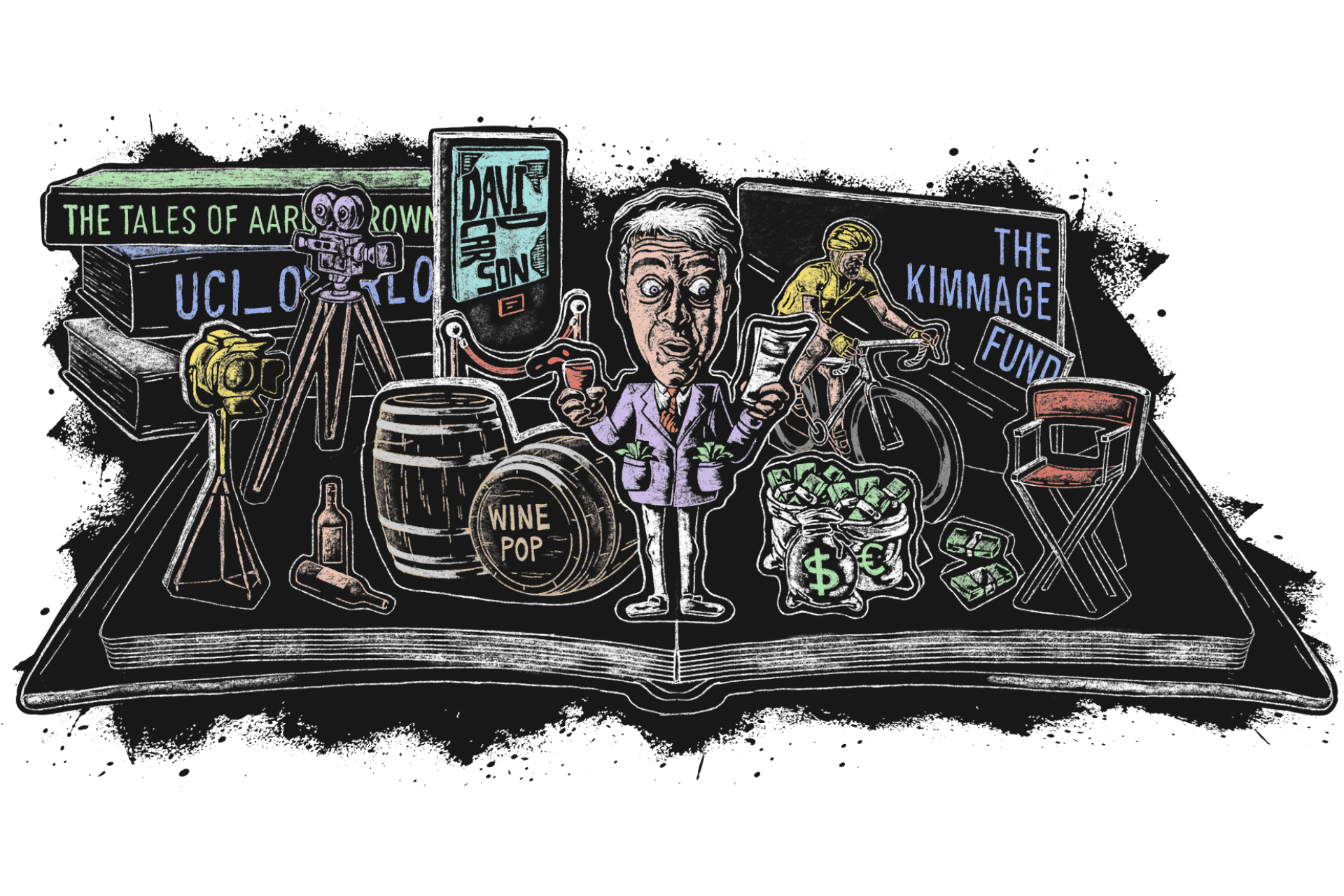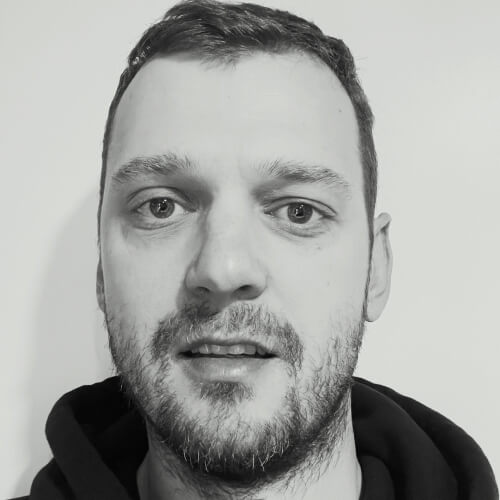Prologue
Few stories have captivated the cycling fraternity quite like the saga of the Paul Kimmage Defence Fund. In early 2013, roughly US$70,000 of the community’s money, all of it donated to a charitable cause, disappeared and was never seen again. It wasn’t just the money that vanished – so too did the enigmatic figure who controlled it: a Canadian national named Aaron Brown, a man of many guises best known as the Twitter personality @UCI_Overlord.
The story had it all. A respected journalist steadfastly pursuing the truth, a governing body flexing its muscle in questionable ways, an outraged community, and, tangled up in it all, a mysterious, shapeshifting antagonist who fled his homeland in pursuit of both opportunity and personal reinvention.
A decade on, the story of the Kimmage Fund’s disappearance remains unresolved. Is it as simple as saying that Brown took the money? If so, what did he do with it? How has he managed to avoid accountability? And what has he been up to in the years since the Kimmage Fund disaster?
In short, Brown has been busy. He’s worked in a range of different fields and changed his name multiple times, but amid all that flux, one thing has remained constant: everywhere Brown has gone, he’s left a trail of pain and anger in his wake.
This is a story that begins in the world of professional cycling in the early 2010s before branching out across industries, continents, and decades. It’s a tale that winds its way down the sleepy streets of small-town Canada, through the hilly vineyards of north-eastern Spain, into the halls of a gritty countercultural art gallery in Barcelona, and through a courtroom in Massachusetts, USA, before ultimately landing in the cut-throat world of film and television.
It’s a long and twisting tale of multiple identities and colliding worlds, of transatlantic drama and mystery. More than all that, it’s a human story of deception, anger, humiliation, and loss. At the heart of it all: Aaron Timothy Brown.
Would you prefer to listen to this story rather than read it? Click play below to hear this story in audio form, as read by the author.

Chapter 1: The Kimmage Fund
This story could begin at any one of several different points. It could begin with Brown’s childhood, growing up in an artsy household in Canada and the US in the 1970s and ‘80s. It could begin in the present day, with his recent movements in north-east Spain. But for our purposes, the story really begins in 2012 with the saga that earned Brown eternal notoriety in the cycling world: his disastrous handling of the Paul Kimmage Defence Fund.
For us, it is this saga – perhaps Brown’s biggest indiscretion in a life of many – that frames everything that’s happened since.
***
In January 2012, cycling’s governing body, the Union Cycliste Internationale (UCI), filed a defamation lawsuit against Irish former pro racer turned journalist Paul Kimmage. The UCI’s then-president, Pat McQuaid, and former president, Hein Verbruggen, had taken offence at comments Kimmage made in the media, not least the suggestion the UCI had overlooked a positive doping test by Lance Armstrong at the 2001 Tour de Suisse.
When Kimmage received a subpoena later that year, compelling him to attend a Swiss district court in December 2012, he found himself in a bind. He’d recently been laid off by the UK’s Sunday Times, leaving him unable to pay the legal fees that were headed his way. Outraged by the UCI’s aggressive pursuit of Kimmage, some members of the cycling fraternity took it upon themselves to set up a crowdfunding campaign to cover the Irishman’s legal fees.
One of the people behind that fund: Aaron Brown.
Brown came to the sport as a fan of pro racing and as an amateur rider from back in the day. But in the early 2010s – then in his late 30s – Brown managed to establish himself as an authority on the inner workings of the sport, courtesy of his @UCI_Overlord Twitter account.
In the words of journalist Joe Lindsey, who wrote a seminal article about the Kimmage Fund drama for Bicycling back in 2013:
“The [@UCI_Overlord] account was funny and knowing, skewering UCI president Pat McQuaid and his attitude and approach to running the sport. Despite being an outsider to pro cycling, [Brown] managed to come across as knowledgeable about the sport and its players and inner workings, often accompanied by a mock-sinister mirthfulness that became his signature phrase: *chuckle*.”

To many who witnessed it, Brown’s rise to prominence was confusing: he seemed more connected than those who’d spent decades in the sport, and even had direct lines of communication into the halls of the UCI. Brown claimed to know and called many pro riders friends but much of the racing community viewed him with scepticism.
Brown was a prolific tweeter and soon ventured out into other areas of the cycling media sphere. He appeared on the Flammecast podcast, the beginnings of his collaboration with Massachusetts-based journalist, editor, and producer, Lesli Cohen. When Flammecast stopped (it’s since been revived), Brown and Cohen decided to collaborate more formally.
The pair created Cyclismas, a cycling satire website that prided itself on providing “an alternative to traditional cycling news coverage”. After launching in time for the 2011 Tour de France, Cyclismas built a small but loyal following.
There wasn’t a formal business arrangement in place between Brown and Cohen but Cohen took on the role of Cyclismas’s editor-in-chief while Brown handled the business side of things and was also the site’s headline contributor, writing under his UCI Overlord persona. It wasn’t a full-time role for either of them – Cohen was busy “editing and doing some writing for different local publications”, and Brown was busy helping out his then-partner Maria Gallardo at the café they ran together in Bridgewater, Nova Scotia, Canada.
UCI Overlord wasn’t the only character Brown played at Cyclismas. He also wrote for the site as “reporter” Frank Mercer, and worked in ad sales as “site publisher”, Bill Thacker. Most visibly, though, Brown appeared as Ripp Finklemann, bombastic host of the Cyclismas Cycling News Network (CCNN) TV series. His offsider: Jonny Gunn, played by Cyclismas video producer Justin Pickens.
When Paul Kimmage was subpoenaed by the UCI in September 2012, Cyclismas was front and centre as the idea of a support fund grew.
Cohen was in talks with Andy Shen of NYVelocity.com as well as the individual behind the acerbic and anonymous Twitter account, Digger Forum, to create a crowdfunding campaign. But with the others reluctant or unable to set up the website widget that would accept donations, the task fell to Cohen.
Donations to the Kimmage Fund were directed through to the Cyclismas PayPal account – the same one that had been created to handle the site’s merchandise sales. The choice to use this PayPal account was seemingly insignificant at the time, but it would ultimately prove pivotal to the whole saga.
Once established in late September 2012, the Kimmage Fund took off. News of the fund quickly spread to all major road cycling news outlets, and then it hit the mainstream press, too. The response was emphatic. Many cycling fans, those in the media, and even pro riders were supportive of Kimmage and outraged that the UCI would target a journalist so pointedly (while, notably, not suing the media outlets involved.)
The fund raised US$23,000 in the first week. And when donations closed on December 31, 2012, around 3,600 people had pitched in, netting a total of US$93,099.
Crucially, all of that money was in the Cyclismas PayPal account, under the sole control of Aaron Brown.

In December 2012, with donations to the Kimmage Defence Fund winding to a close, Brown transferred US$23,164 from the Cyclismas PayPal account to Kimmage to pay for the legal fees the journalist had accrued to that point. With that transfer made, US$69,935 worth of donations remained. But things were about to get messy.
By the time Brown had sent money to Kimmage, the UCI had already suspended its legal action against the Irishman. As it turned out, the governing body had a bigger problem on its hands.
A couple months earlier, the US Anti-Doping Agency (USADA) had handed Lance Armstrong a lifetime ban for doping throughout his career. In a 202-page document explaining the ban, USADA came down hard on the UCI, accusing the governing body of a long-held laissez-faire attitude toward doping.
In response, the UCI launched a “fully independent external commission” into doping and its own handling of the issue. It was at that time that the UCI suspended its legal action against Kimmage, “pending the findings” from the commission. McQuaid and Verbruggen, both individual parties to the case, followed suit.
As 2012 rolled into 2013, Brown and his then-partner Gallardo sold their café in Bridgewater and moved with their son – then on the cusp of starting school – to Girona, Spain. Brown had a plan to take Cyclismas to the next level; to visit races and riders in person, rather than covering the sport remotely. Moving to one of professional cycling’s hotbeds seemed like a good option.
Brown had convinced Pickens to join him on his European adventure and so in January 2013, Pickens and his family packed up and flew over from Canada to Spain as well. Pickens hadn’t signed a contract – he’d just made a verbal agreement with Brown that he’d be paid on the 15th of every month.
According to Pickens, it didn’t take long for his promised salary payments to stop. His January pay came through in full and on time, but in February it came in late (and, strangely, via PayPal). His March pay was late again, and less than he was owed. That was the last payment he received.
By April, Cohen was starting to suspect Brown had been paying Cyclismas wages from the Kimmage Fund. She says Brown admitted as much to her. Indeed, in an audio recording from late April 2013, Brown tells Pickens the latter had been paid from the charitable fund. “Technically there was funds that I dispersed for you, to you from the Kimmage Fund directly,” Brown says, “which I reimbursed from my personal funds.”
When Cohen got access to the Cyclismas PayPal account for the first time, it showed a balance of $0, with a series of transfers between late December 2012 and early March 2013 to Siroque Holdings – a company in Brown’s control.
When Cohen and Kimmage both demanded an accounting of the Kimmage Fund, Brown declined. On April 30, 2013, Cohen filed a lawsuit to dissolve the Cyclismas business partnership. Further legal action would follow.
Brown countersued Cohen for allegedly defaming his UCI Overlord personality (among other allegations), claiming US$2 million in damages. And then in September 2013 a Wisconsin judge, Bill Hue – himself a donor to the Kimmage Fund – initiated a class action against Brown, on behalf of all donors.
It was around this time that newly elected UCI president Brian Cookson reached out to Kimmage to confirm the UCI’s legal action against the journalist would be dropped for good. It seemed the money in the Kimmage Fund would no longer be required.
With public pressure mounting, Brown tried to deal with the money he’d moved out of the Cyclismas account, launching the Kimmage Fund Refund website to handle refunds.
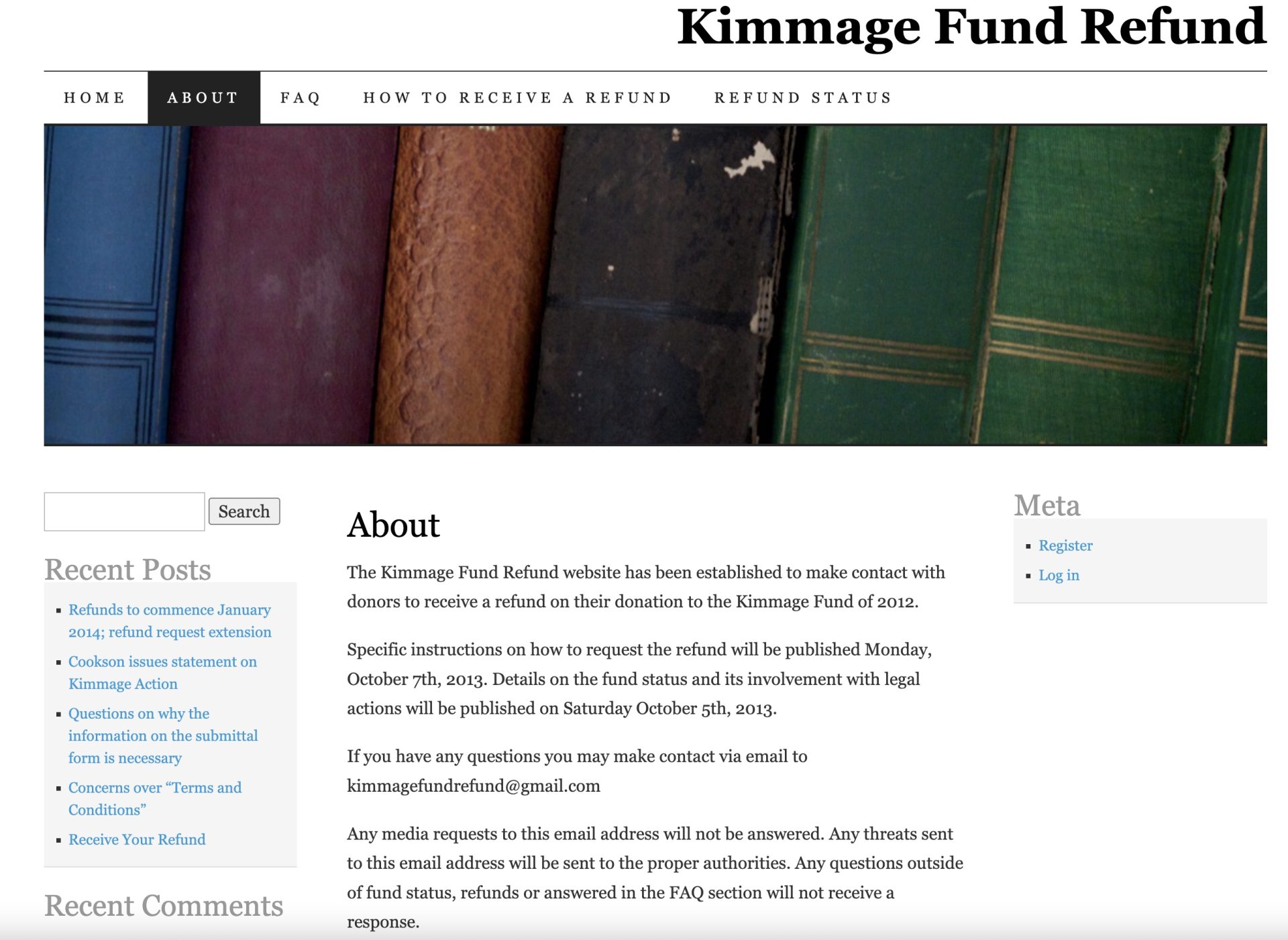
In a post on his refund site, Brown declared there was US$64,821.75 remaining of the Kimmage Fund and that donors who wanted a refund would get 70% of their donation back – only 30% of the fund had been used. Brown also vowed to donate any unclaimed money to a charity of Kimmage’s choosing.
It’s hard to say exactly how many refunds Brown issued in the months that followed. Co-founder of Escape Collective, Wade Wallace, received a refund for the contribution he made, and Brown also tried to refund Bill Hue’s donation (which Hue promptly rejected).
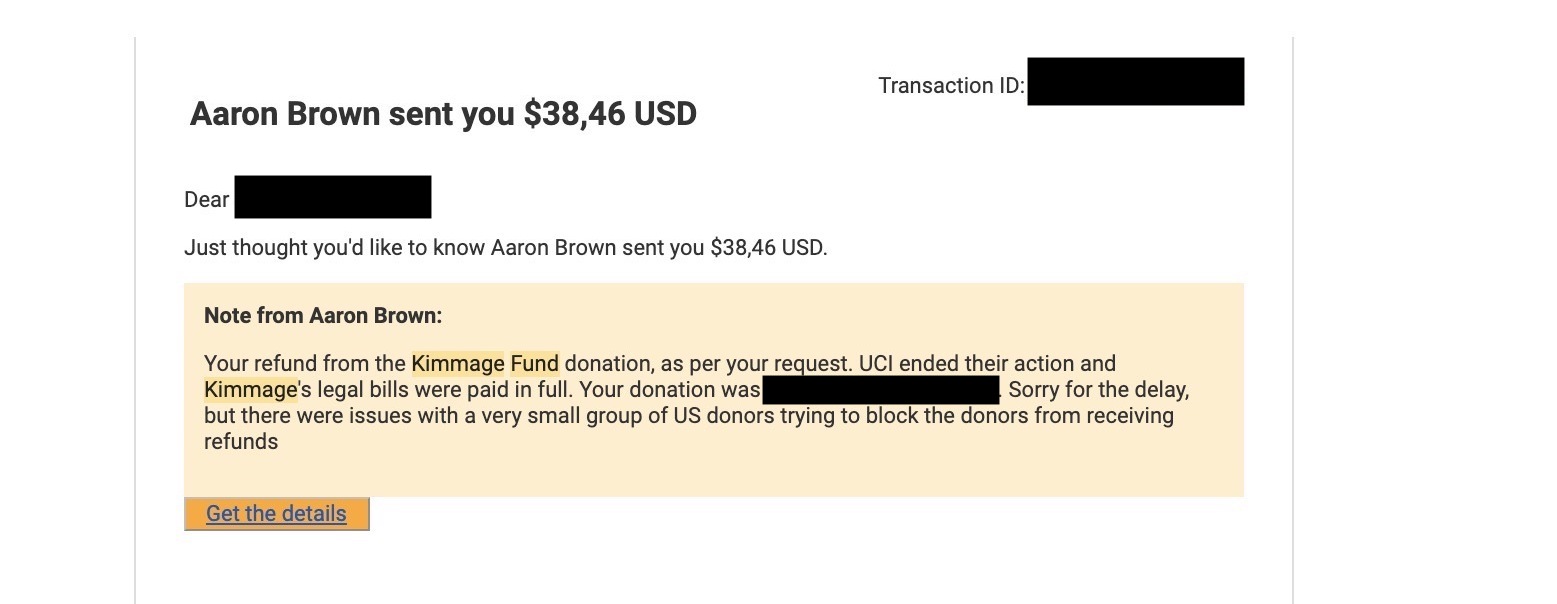
Regardless of how many donors received refunds – Cohen thinks almost nobody did – it was throughout this process that we were starting to see the final tendrils of Brown’s association with the cycling world. He’d long stopped posting as @UCI_Overlord on Twitter (his last post was on May 8, 2013, answering questions about the state of the fund) and his last article on the Kimmage Fund Refund site was on December 31, 2013, saying donors would have until June 1, 2014 to claim their money back.
The case of the Kimmage Fund would rumble on in the Massachusetts court system for several years to come. By that point, though, Brown had long left the sport behind – he’d been building an entirely different life for himself, well away from cycling.
Interlude: UCI Overlord on the inside?
While Brown had used his @UCI_Overlord Twitter account to skewer Pat McQuaid, there was a rumour at the time of the 2013 UCI presidential election that Brown was actually helping McQuaid with his presidential campaign.
Brown denied that rumour at the time. In early 2023, I asked McQuaid via email whether the rumour was true; whether Brown had indeed been helping him in the background. “Most certainly not,” McQuaid replied.
Where did the rumour come from? Perhaps from an email that Brown sent to McQuaid in March 2012, that outlined many of Brown’s frustrations with the UCI and was later circulated on various online forums.
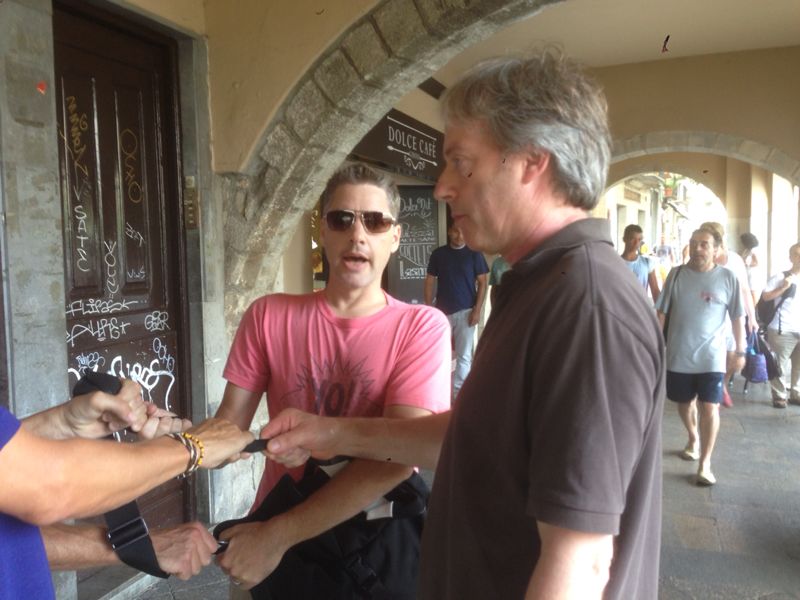
Chapter 2: Timmer Brown, wine blogger
In cycling circles, Catalunya is best known for the pro-cyclist-filled city of Girona, and as host of a notoriously hard men’s WorldTour stage race: the Volta a Catalunya. But the hilly territory in north-east Spain – a region that’s long sought independence from that nation – is also regarded as one of the country’s top winemaking regions. High quality drops from Priorat, Montsant, Terra Alta, and Empordà, plus the sparkling wines of Cava and Corpinnat, are all making a splash both in Spain and abroad.
It was into this world of Catalan wine that Brown was trying to embed himself.
In a radio interview on Barcelona City FM in 2017, Brown explained that he got into the wine business by accident. A meeting with winemaker Marta Arenas at the Tocs de Vi wine festival in Girona in mid-2014 had convinced him of an opportunity: promoting Catalan wines to the English-speaking world.
But Brown wouldn’t start his new venture alone.
Brown’s business partner in those early days was a man named Matthew. That’s not his real name – he only agreed to be interviewed for this story on the condition that his real name wasn’t associated with Brown in any way.
A North American expat like Brown, Matthew had worked in restaurants and bars back in the US so, like Brown who’d worked in cafés, he was familiar with the wine scene.
The way Matthew remembers it, Brown pushed unusually hard for their friendship to take off. And when Matthew and his wife separated, with Matthew eventually moving out, he needed a place to stay. Brown and his partner Gallardo had also recently separated – she’d headed back to Canada with their son – and so Brown had space in his apartment.
Brown and Matthew lived together for a few months but it wasn’t until they’d both moved out that they’d start collaborating. In late June 2014 they started up CatalunyaWine.com, created a handful of social media accounts, set up a YouTube channel, and got to work.
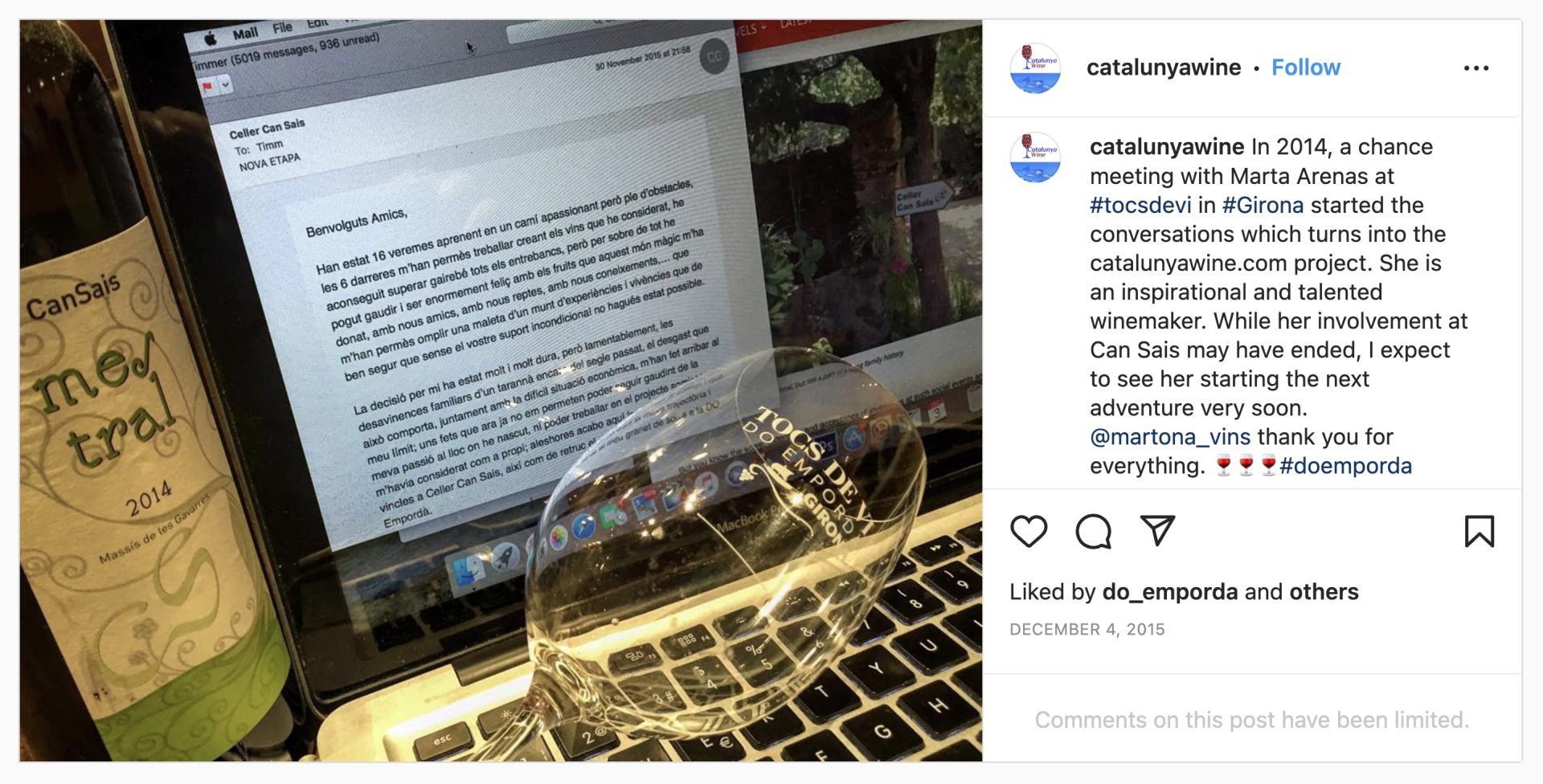
Brown and Matthew visited wineries, interviewed winemakers, attended industry events, wrote articles, and shot videos. Much like at Cyclismas, Brown handled the business side of things – “running the website, answering emails, speaking directly to clients”, Matthew says. But in contrast to his starring role at Cyclismas, Brown stayed behind the scenes at Catalunya Wine.
“He kind of saw me as the face and him as the brains, I guess you would say,” Matthew tells me via video call. “Obviously, once I started learning about his past, it quickly made sense why I had to be the face of the operation,” he adds, with a knowing smile.
Brown was apparently so keen to put distance between himself and his much-publicised missteps in the cycling world that he didn’t just keep himself off camera – he also changed his name. From that point on he’d go by Timothy Brown, Timmer Brown, or Tim Brown.
“A couple of people [said] ‘But your first name’s Aaron?’ And he goes ‘Oh, when you Google, there’s so many Aaron Browns so I decided I would go with my middle name. And to be honest I’ve always preferred my middle name over my first name,’” Matthew recalls.
“At that point I didn’t think he was a bad guy, but I knew he was kind of … what would we say – 10 pounds of shit in a 5 pound bag? I knew he was just completely full of shit. And I would listen to him spin this bullshit about things.”
Matthew smiles broadly as he shares this memory, as he does regularly throughout our conversation. As turbulent a time as it was for Matthew, he’s now able to see the humour in it all – the absurdity of Brown’s behaviour.
Through 2014 and into 2015, via social media and through their website, Matthew and Brown established themselves as an authority on the Catalan wine scene. They built a rapport with many individuals in that scene, not least the owners of several local wineries. Those relationships would give rise to their next venture: a documentary film about the winemakers of Catalunya.
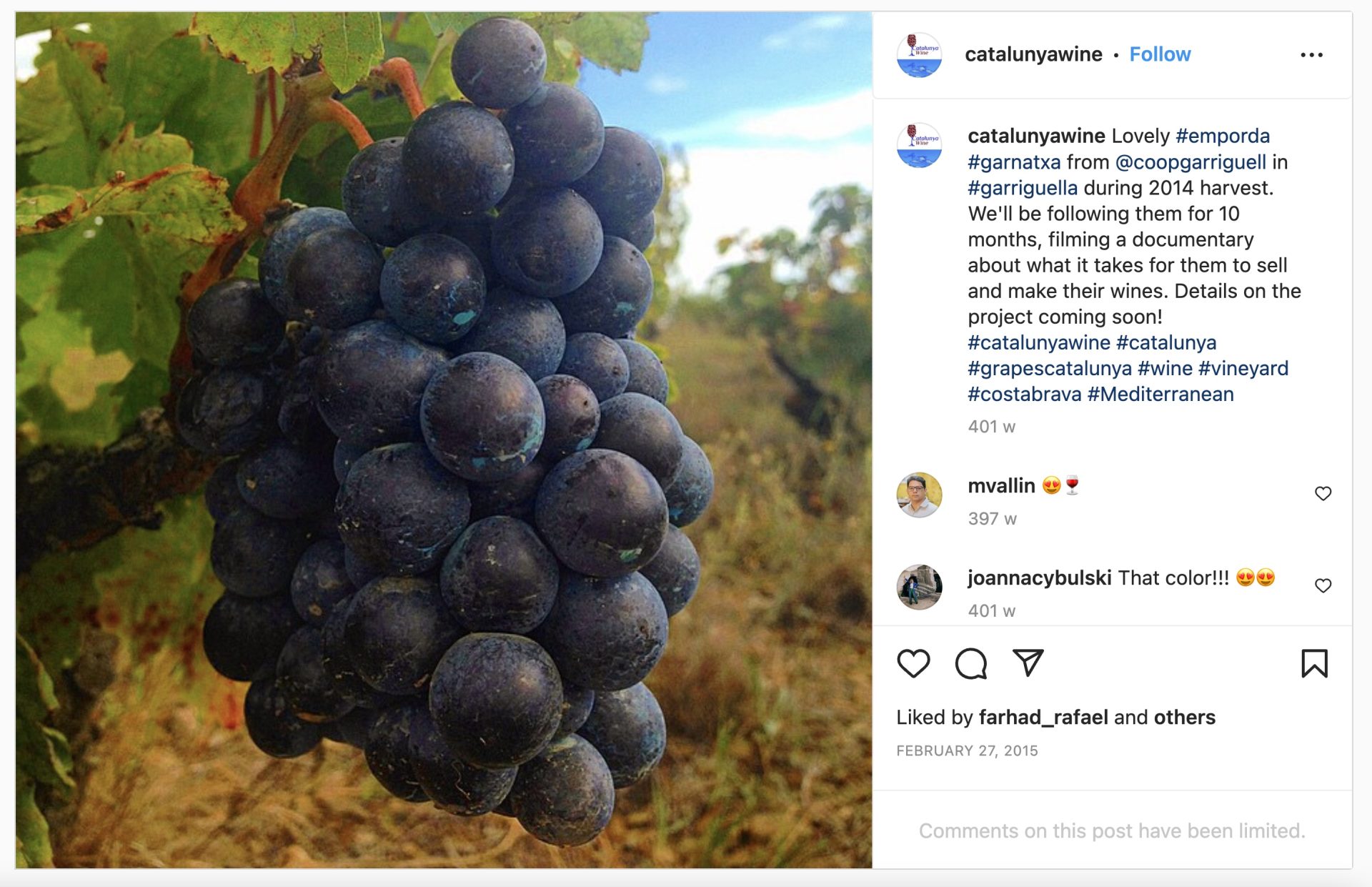
Four wineries signed on to the project, paying to appear in the documentary: Cooperativa Garriguella, Sao del Coster, Terra Remota, and Torre del Veguer. Brown and Matthew would visit each winery throughout much of 2015 to follow and document the winemaking process.
The exact amounts paid by the wineries appears to have differed by business and by month. Former manager of Sao del Coster, Xavier Barrachina, told me his winery paid a total of roughly €2,700. A representative from Torre del Veguer explained that they paid around €2,000 in total.
But with each winery paying several hundred euros a month, the future was looking bright for Catalunya Wine. Brown convinced Matthew to quit his job in Barcelona and throw himself into the business full time. Much like he’d convinced Justin Pickens to move from Canada to Girona to help build Cyclismas only a couple years earlier.
Brown built a website for the documentary project, a social media presence, and started releasing short clips from the winery visits he and Matthew made throughout early 2015. The full film was due for release in 2016.
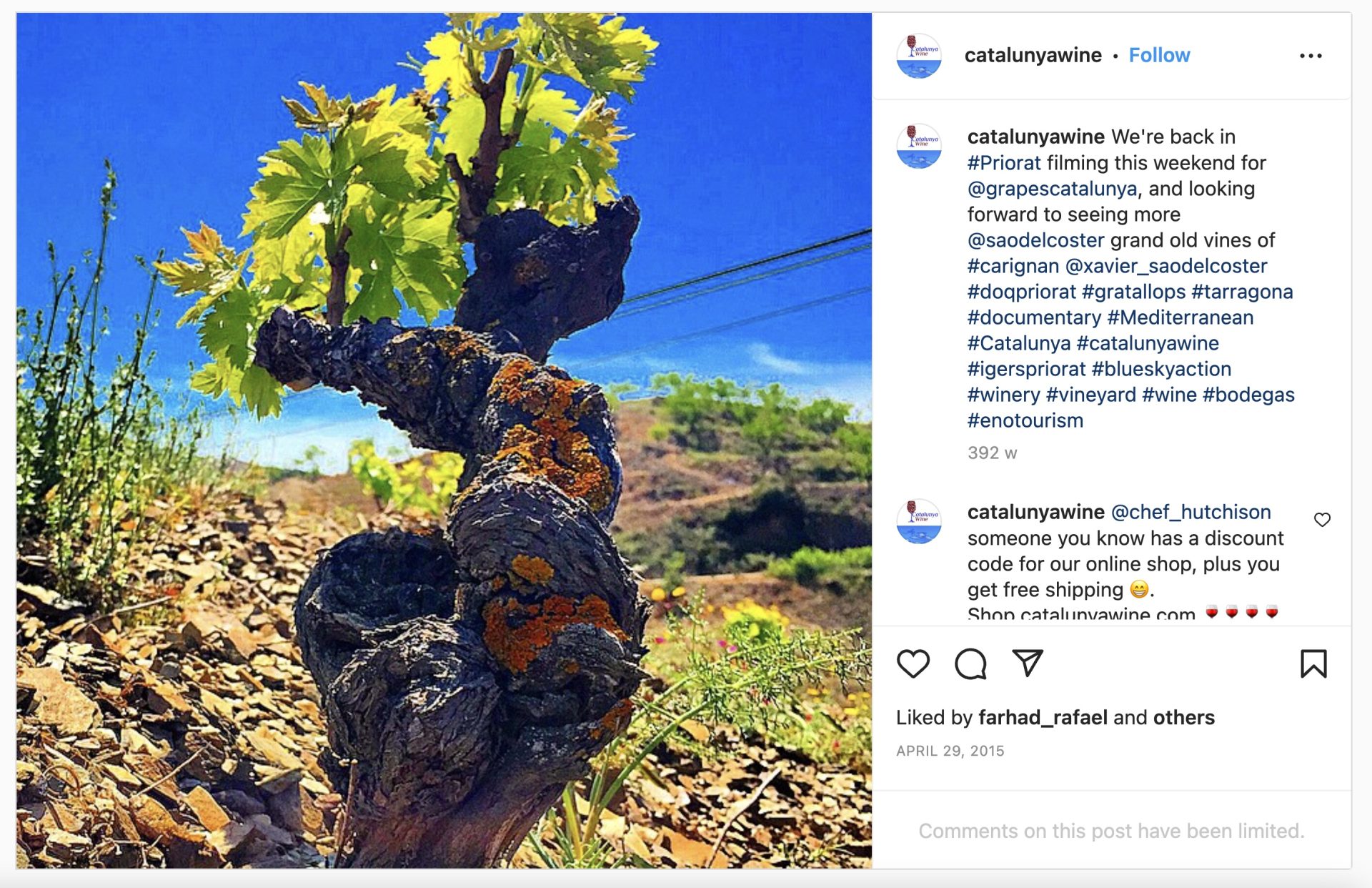
But soon after the project began, things started to go south. And again, there was more than a passing resemblance to how things went at Cyclismas.
“My first salary payment came in late, and [Brown’s] like, ‘Oh, I’m just waiting for checks to clear’,” Matthew recalls, smiling again, knowing now what would follow. “It did eventually come, but not [before] my landlord was asking me about it [for rent]. Every month it was two or three more days later. It just got kind of later and later until eventually him and I started arguing.
“I was like ‘I left this job to start this. You said the money is there. So why isn’t the money there on time?’ He said, ‘Well, you know, it’s got to go through here and there, it takes time to clear. If they’re late, sometimes we’re going to be late.’”
At face value, the explanations made sense to Matthew – he figured he just had to be patient. But it wasn’t easy.
“One month, two weeks later, after my rent was due, I still hadn’t received payment,” Matthew recalls. “And I basically said [to Brown] ‘I’m not going on any [winery] visits, I’m not throwing any more money at this until I get paid.’ At that point he started getting really defensive and I was just saying ‘Aaron, where’s the money? Where is the money?’ And he’s like ‘It’s coming, it’s coming. We’ve got some clients who haven’t paid yet.’”
Just as Cohen had her suspicions about Brown’s handling of the Kimmage Fund, Matthew’s “spidey sense was going off”. He contacted the wineries himself, asking why the payments were late.
“I got two responses back saying ‘Oh, we already paid this month,’” Matthew says. “And one of them even actually attached the transfer statements with the dates and everything.”
May 2015 emails seen by Escape Collective, between Brown, Matthew, and the proprietors of Sao del Coster, confirm the exchange Matthew speaks of.
In the emails, Matthew asked why the April and May invoices hadn’t been paid. The winery owners replied to say they had been paid, and that Brown previously confirmed as much. Brown interjected and said that, in fact, the payment hadn’t been received. The winery owners responded by pasting in an earlier reply from Brown, including the line: “We’re all paid up for the documentary – just received it today. Thank you!” Attached to that email: PDF receipts for the two payments, one for €500, one for €300.
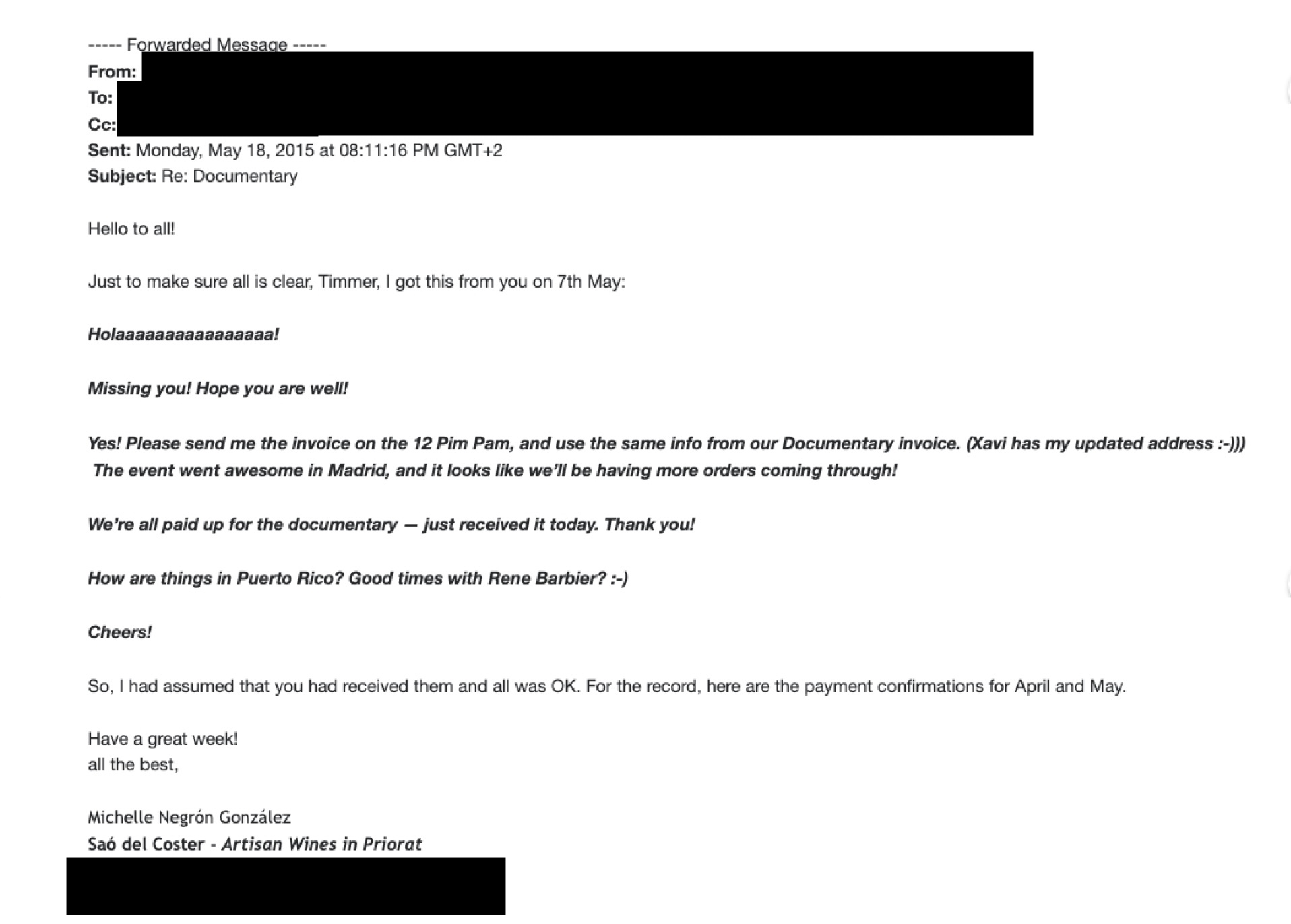
Following that email exchange, Matthew called Brown, challenging him on his lie.
“He’s just like ‘[Matthew], I can’t talk to you right now because your tone – you’re becoming very aggressive,’” Matthew recalls. “’I think you need to take some time to cool off and settle down and maybe we can talk when you settle down.’ And of course, I said, ‘No, I want to speak to you face to face.’”
After some insistence from Matthew, Brown agreed to meet. They met in a “very neutral” restaurant café they were both familiar with – a place they’d sometimes met on their way out of town on Catalunya Wine business.
“I knew something was off during that meeting when he was early,” Matthew recalls. “He had never been early. I walked in on time and here’s sitting there already. And I’m just like, ‘OK, this is interesting.’”
Matthew believes Brown arrived early to set up a recording of their meeting. He asked Brown to put his phone on the table and turn it off, which Brown refused to do. Matthew walked away from the meeting. His suspicion stemmed from an earlier conversation they’d had.
“He had told me in the past that he had recorded people’s conversations and spliced them in such a way to make … basically done soundbites, manipulated the recording,” Matthew says.
Matthew explains that not long after their meeting, in May or early June 2015, Brown locked Matthew out of his Catalunya Wine email address. And then Brown started reaching out to their clients.
“I found out that he was telling people that I was having a nervous breakdown, a psychotic episode,” Matthew says. Brown would tell them “‘[Matthew’s] been under a lot of stress lately. He’s just not himself. So if he tries to contact you …’ So anything that would come from me [was] something that’s in my head. All of a sudden, I guess I’m a paranoid schizophrenic.”
Locked out of the business he helped create, Matthew cut ties with Brown. He reckons he’d probably invested around €5,000 to fund the business by that point – money he would never get back. Given he was still recovering financially from his recent divorce, losing money on Catalunya Wine was especially painful.
Just as Brown and Matthew’s partnership was falling apart, so too was the documentary.
Brown emailed Sao del Coster winemaker Xavier Barrachina in early 2016 to explain that the film had been delayed. He claimed that his “distribution company” wanted several changes but that editing was due to be completed within weeks. He told Barrachina a distribution deal was being negotiated with Netflix, and that he was working towards “theatre views”.
Barrachina never heard from Brown after that email.
In November 2016 – 10 months after the film was due to be released – Brown was still claiming the documentary was on its way. Ultimately, the film’s website and social pages were taken down and all that exists of the documentary in the public domain now is a 12-minute preview video – see below – narrated by Brown, featuring one of the four vineyards: Torre del Veguer.
To put it mildly, the preview suggests a film well below the standard of anything you’d expect to see on Netflix or in cinemas. Both the lighting and the audio quality are terrible – not surprising given, as someone at the Torre del Veguer winery told me, Brown “filmed everything with an iPhone with a broken screen.”
The failed documentary was far from the only drama that befell Brown’s time in the wine scene.
In the months after Matthew was ousted from Catalunya Wine, Brown organised a wine-themed conference in Barcelona. Among those he invited was a representative from another wine website; a woman we’ll call Julia (not her real name). Brown offered to pay for Julia’s flights to and from the conference, but when the conference fell through – after Julia had already bought flights – he reneged on that promise.
In an email to Julia in December 2015, Brown said he thought the money transfer had already been made, apologised several times for not yet reimbursing her, and said “it will get done!!”

In January 2016, still yet to be reimbursed, Julia sent two follow-up emails. Finally, on January 28, someone called John Steves replied on Brown’s behalf claiming to be the “Catalunya Wine Administrator”. ‘Steves’ suggested Julia could already have sought a refund from British Airways and so he wasn’t inclined to reimburse her for the flight.
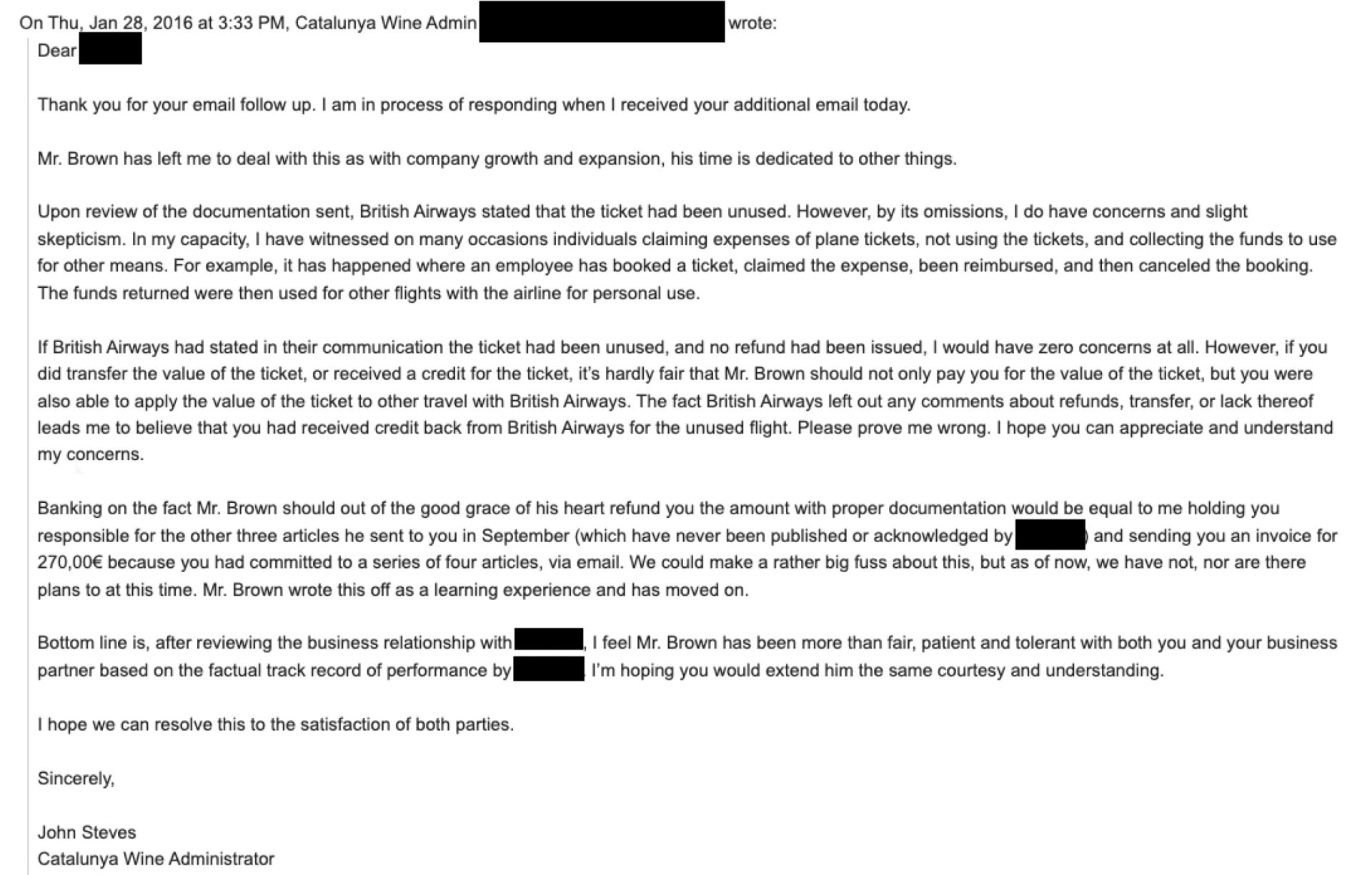
It’s unclear whether John Steves is a real person or just Brown assuming another persona, just as he did at Cyclismas. Julia is inclined to believe the latter.
Either way, in his email to Julia, ‘Steves’ doubled down. He suggested that Brown had sent four articles to Julia to publish on her site and that even though they weren’t published, Brown’s efforts were payment enough in exchange for the flights.
“We could make a rather big fuss about this, but as of now, we have not, nor are there plans to at this time,” ‘Steves’ wrote. “Mr. Brown wrote this off as a learning experience and has moved on.” Julia replied to explain that the first article had been paid and that “no contract for the remaining articles was signed.”
Julia and her website were never reimbursed for the flight.
Interlude: Verbruggen gets his man
While the UCI dropped its defamation lawsuit against Paul Kimmage for good in late 2012, in early 2014, former presidents Pat McQuaid and Hein Verbruggen both reactivated their case. McQuaid withdrew a couple weeks later but Verbruggen pressed on.
In April 2016, after a years-long ordeal, a Swiss court found that Kimmage had indeed defamed Verbruggen. Kimmage was fined 12,000 Swiss Francs plus costs, ordered to publish the court’s decision in three media outlets, and was not allowed to assert that Verbruggen “knowingly tolerated doping, concealed test results” and more.
Kimmage’s fine and legal costs, which should have been covered by the Kimmage Fund, were instead paid by Jaimie Fuller, then-CEO of compression garment company Skins. While Fuller no longer has the records – Skins went into liquidation in 2019 – he believes he might have spent between 50,000 and 100,000 Swiss Francs covering Kimmage’s bills over the years.
By late 2016, Brown was gravitating towards another opportunity that would fall apart in spectacular fashion and ultimately spell the end for his time in the wine scene.
In joining the team behind Wine.Pop, a newly rebranded app for wine-lovers, Brown sought to use his network to encourage wineries to pay to be featured in the app. While he was contracted with Wine.Pop until the end of December 2016, company founder Tom Voltz gave Brown his marching orders weeks earlier than that.
While Voltz wouldn’t speak to Escape Collective about his time working with Brown, the relationship seemingly came to an acrimonious end. One source explained that Brown had made grand promises about the money he was going to bring in for Wine.Pop, but ultimately fell well short of those promises.
It was around this time – and partly because of his involvement with Wine.Pop – that the wine scene was starting to catch on to Brown and his colourful past. British wine blogger Jim Budd would be the one to make the big reveal.
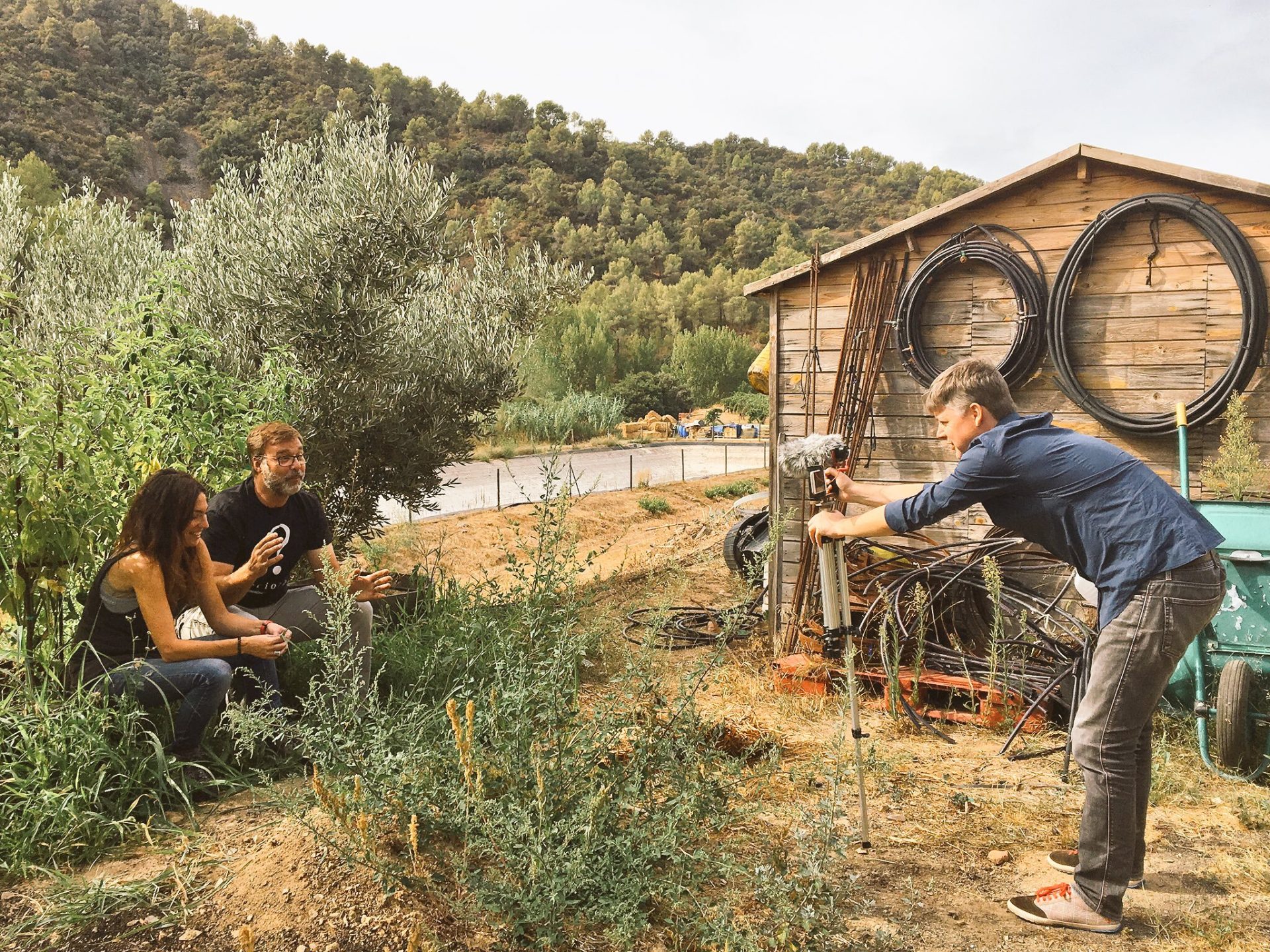
Budd knew all too well about Brown’s past life – he’d been a donor to the Kimmage Fund himself – and after hearing that Brown was plying his trade in the wine game, he managed to connect the dots. Some of his friends were ambassadors for Wine.Pop and with Brown also involved, Budd was concerned for his friends.
And so, in late 2016, Budd published a pair of articles exposing Brown’s past to the wine world. The first, in November 2016, was a comprehensive breakdown of Brown’s role in the Kimmage Fund disaster, his move into the wine world, details of the failed documentary, and even information about Brown’s outstanding child support debts back in Canada.
When Brown was let go by Wine.Pop in late 2016, Budd posted a follow-up, celebrating Brown’s departure. “The very good news is that Tim Brown (aka Aaron Timmer Brown) has been sacked by Wine.Pop,” he wrote. “This latest episode should persuade anyone in the wine industry in Catalonia and the rest [of] Spain that it is a very bad idea to employ Tim Brown (aka Aaron Timmer Brown) in any capacity whatsoever.”

Meanwhile, Lesli Cohen – Brown’s former business partner at Cyclismas – was also contacting members of the Catalan wine scene, providing more information about Brown’s past.
“I was on blast on Twitter [to] anybody that would listen,” Cohen tells me in early 2023, smiling at the memory. “My argument was that the guy had stolen money from us – we were just trying to get it back.” Cohen admits she was too vociferous in her posting – she had two Twitter accounts shut down as a result.
In the world of Catalan wine, people were starting to talk. One source from the Barcelona hospitality scene recalls going to a wine tasting and hearing Brown’s name come up immediately. She was warned to stay away from him, to avoid talking to him.
And Brown was well aware that his past had been exposed; that people were talking about the Kimmage Fund disaster. In explaining it to those who asked, Brown would paint himself as the victim.
“In his explanation, he goes, ‘I feel like […] I was an easy target because I had made a decision to leave the country and then the money went missing shortly after I had left,’” Matthew recalls. “And I kind of feel like they put it on me because it just kind of fit a narrative that I left with the money.’
“He did a pretty good job of selling for a while that he was kind of the victim of […] a witch hunt. And he hadn’t [yet] done anything to me for me to question that.”
By early 2017, Brown’s efforts in the wine world were starting to slow; whether by doors closing in his face, running out of steam, or some combination of the two. By this point, though, he was starting to focus his energy elsewhere.
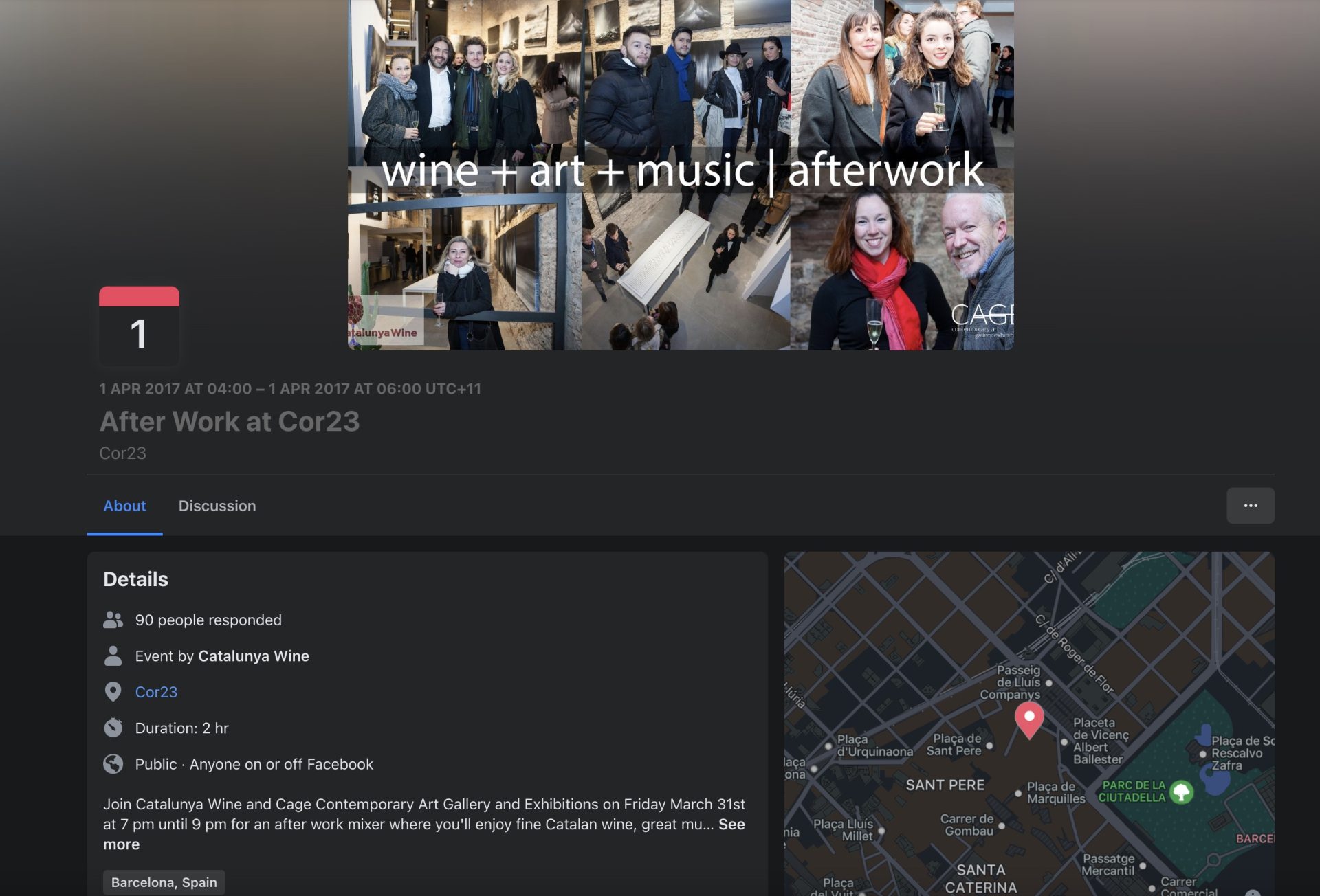
Chapter 3: Tim Brown, PR agent
The celebrated American graphic designer David Carson doesn’t seem like the kind of person Aaron Brown would cross paths with. Carson, known as the “Godfather of Grunge,” has done design work for an eclectic mix of clients ranging from the Dali museum, to major consumer brands including Pepsi, Nike, Microsoft, to the industrial rock band Nine Inch Nails. His distinctive collages feature unconventional layouts and often-chaotic typography, frequently at odds with the traditional “rules” of graphic design.
But around the end of 2018, Brown approached Carson, offering to handle public relations on some projects in Barcelona.
Check out old bios on Catalunya Wine and you’ll see Brown claim that he’d worked in PR and marketing for well over a decade.

Those claims aren’t exactly true – Brown hadn’t worked in PR and marketing for 15 or 20 years when he claimed as much in the mid-2010s – but much of his work since leaving cycling behind has been promotional in nature.
In July 2017 Brown registered TemplarBrown.com for the agency he’d run his PR ventures through in the years that followed. The site promoted services in “operational, public relations, and marketing strategies” and claimed “industry expertise in film, food and beverage, technology, and social media.”
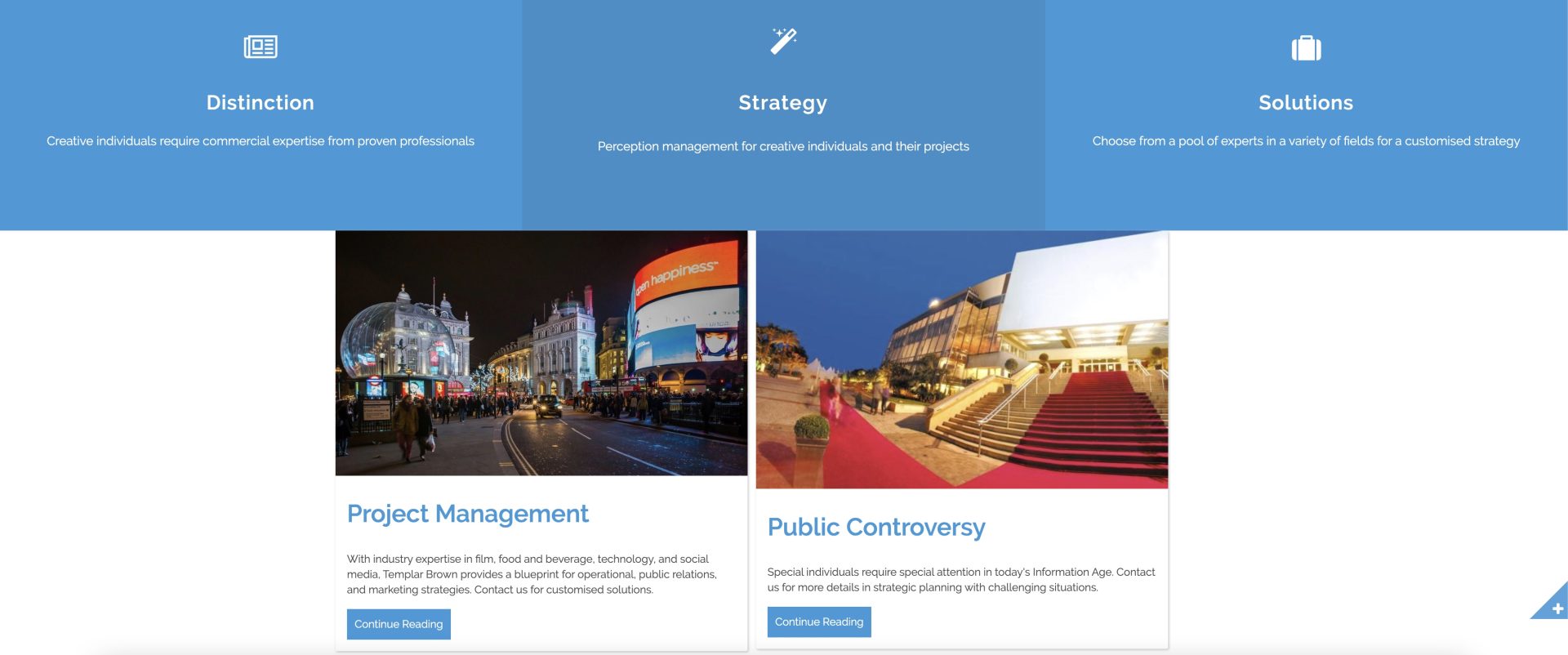
Just as Brown had tried to stay out of the spotlight at Catalunya Wine, there was no hint who Templar Brown was: the website included no client roster, office address, employee bios, or any other information you might expect. In other words, not the sort of agency that might attract the attention of a man like Carson. But Brown had another in.
“He had this great connection with this gallery and it’d be a great place to show all my new work,” Carson tells me via video call. “And, of course, that got my attention. I didn’t know him from anything or really anything about him, but he did seem connected with this gallery.”
That gallery was Haimney, a then-new, three-story multi-disciplinary space in Barcelona co-owned by two Argentinean artists and DJs. The pair built it from nothing in an abandoned building, “without water, without electricity … we [renovated] everything,” says Matteo (not his real name), one of the founders. “We started doing multi-disciplinary events for counter-cultural people, trying to give a new approach to art in Barcelona. It was going really well. And that’s when Tim came.”
A collaboration between Brown and social media strategist Dot Lung, in late 2017, resulted in one of the few online videos post-cycling in which Brown actually appears on camera, rather than behind the lens.
Matteo met Brown through a mutual contact – an “Instagram strategist” named Dot Lung whom Brown knew through Barcelona’s expat community – and the pair struck up a deal.
Brown agreed to promote the gallery, in return for a commission on sales he brought. He’d also be able to use the gallery as an office, lending a kind of legitimacy to his future endeavours. He set up shop in November 2018, around the time he made contact with Carson.
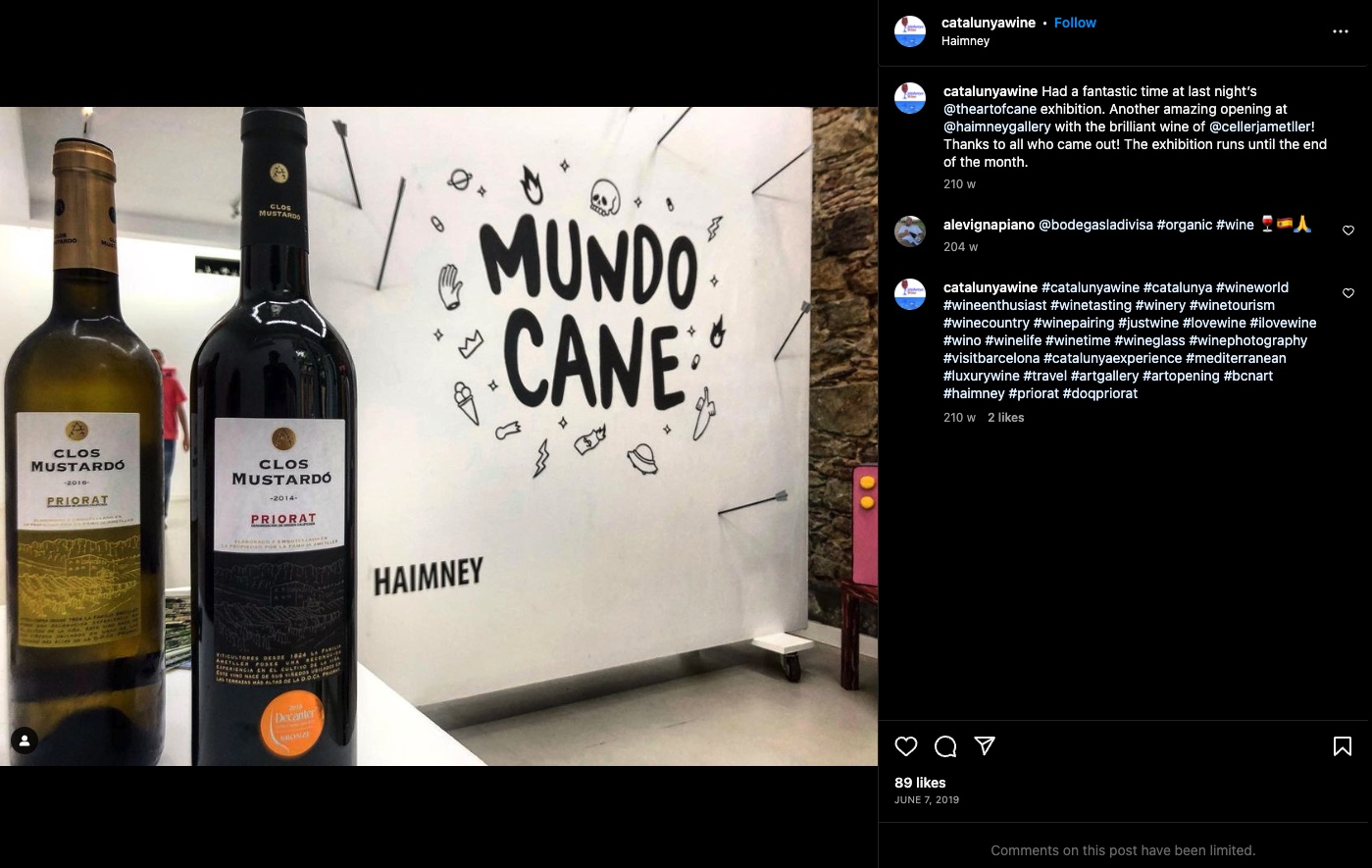
Brown worked with Carson to prepare an exhibition of the designer’s works at Haimney in February 2019. In his discussions with Brown, an off-hand remark from Carson led to a complementary project idea: a book of the works featured in the exhibition.
“I think I said, ‘We’ve got all this art and there’s so many stories with all of it. I certainly should do a catalogue and we could even do a book’, kind of kiddingly,” Carson recalls. “And in typical Tim fashion, without batting an eye, he just kind of smiled and said, ‘OK, we will. We’ll do a book, no problem.’ I was like, ‘Whoa, that was easy.’ And that was the start of a real fiasco.”

Brown claimed to Carson that he had the connections necessary to print the book, and pushed Carson to advertise it on his social media profiles and encourage pre-orders. Carson and Matteo say that, in a situation all too reminiscent of the Kimmage Fund, Brown ended up with control of the pre-order funds. “The money was going to an online service page named after Haimney, but [Brown] controlled that and [redirected] the money,” says Matteo. “He was dealing with all the details; I never saw any money.”
Carson says he didn’t think to set up his own account to collect pre-orders; Brown was dealing with the printer and would give them the green light once pre-orders reached a certain threshold. “It would have been one less headache for me, actually,” Carson says. “‘OK, great, a separate account just for the books and it doesn’t get confused with anything else.’”
According to Carson, Brown told him they weren’t getting enough pre-order deposits to print, and kept urging Carson to push his followers to order copies. But Carson grew increasingly concerned as Brown “kept hedging and hawing on who was actually doing the printing, and how many [copies].”
“It just didn’t seem to be adding up,” Carson says. “But I was in pretty deep, because I’d been advertising this book all over the world. People had been sending money to his account.”
With Brown maintaining not enough orders had come in to justify printing, Carson finally grew angry and re-took control. He sent what he calls a “Hail Mary” to a successful friend, asking whether he would take on the project.
The book, Carson’s fifth, was eventually published as Nucollage.001 by Hula Media. Hula got in touch with the 110 people around the world who’d pre-ordered the book and sent them a copy – a significant expense. “All that deposit money had gone to Tim,” says Carson, who estimates he lost €5,500 on the project.
Brown gave him an excuse. “Something about, ‘Well, yeah, he got money, but he had expenses [from the show],” Carson recalls. Matteo also lost money he’d expected to get from selling Carson’s exhibition works and the book; money that would cover expenses he’d had, like Carson’s plane ticket and accommodation.
The book debacle wasn’t the only headache that Brown caused for Carson.
Carson recalls that Brown had pushed him to put his works on an art website called Artsy.net. “I said, ‘Oh, I definitely, absolutely don’t want that,’” Carson says. “’It’s going to take away the value. Anybody and their brother can go on this site and sell their drawings. No way do I want to be on that site.’ And [Brown] goes, ‘OK, OK, I got it.’
“A few days later there was something just about the way he had reacted that I just didn’t feel too good about. And I think literally in the middle of the night I went to that site and, sure enough, there I was with all my work for sale.”
Unknown to Carson, and directly against his wishes, Brown had all the works in the exhibition photographed and uploaded to Artsy. Any money made from sales, Carson says, was set up to go to Brown.
“I was blown away,” Carson says. “I was so clear that no way could it appear on this site, and he assured me it wouldn’t. Some effort – some secret effort without me knowing – went into setting this up.”
Furious, Carson demanded his art be taken down immediately, which, he says, it was. Representatives of Artsy.net refused to confirm or deny Carson’s version of events; that Brown had uploaded his art to the site without his knowledge. Of note though, an artist page for Carson does appear to exist on the site, but no artwork is currently available for purchase.
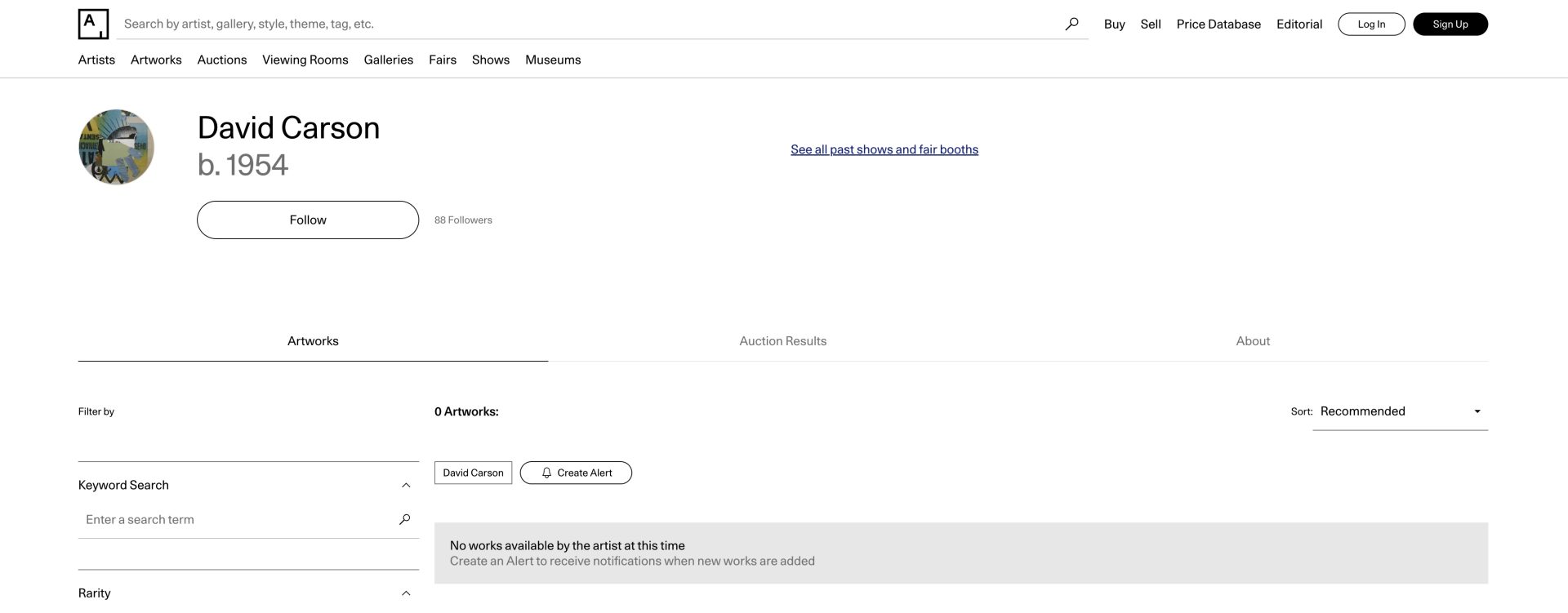
Being several thousand Euros out of pocket isn’t what bothers Carson. “It wasn’t that we lost some horrendous amount of money,” he says. “There were all these false pretences. It was just sleazy, you know, but with a smile and with an assurance that everything’s going to be fine.”
Matteo feels similarly aggrieved. He and his partner were forced to permanently close Haimney in 2022 following COVID-19 lockdowns, and he wonders whether it might have been different had Brown actually done what he claimed. “He was like ‘the commercial guy’ for the gallery [but he] never brought business” he says, shaking his head on our video call. “Never brought a buyer, never brought someone to rent the space. He was saying he was working for me, but actually I was working for him and he was using the free space.”
By the time Haimney closed for good, Brown was long gone, having departed in February 2020. TemplarBrown.com was reduced to a single page bearing nothing but a logo and a contact email address.
But Brown hadn’t been idle; in his time using Haimney as an office he’d been working on yet another personal reinvention.
Chapter 4: Tim York, screenwriter
If Brown’s association with graphic design icon David Carson seemed unlikely, then his exploits in the world of film and television are almost entirely unbelievable. Screenwriter and executive producer credits for multiple upcoming feature films, mixing with minor Hollywood stars, repeated mentions in Hollywood Reporter magazine – for Brown, a long-time film buff, it must have been a dream.
The move into a new industry meant another new identity. You won’t find the names “Aaron Brown”, “Tim Brown”, or “Timmer Brown” linked with any of his production or screenwriting work. You will if you search for “Timothy York” or “Tim York”, though. (For the sake of clarity, I’ll continue to refer to him in this story as “Brown”).
One of Brown’s earliest forays into the world of film and television was an idea for a TV series he’d call ExPats, a dramedy following the lives of six expats living in Barcelona (a scene Brown knew well).
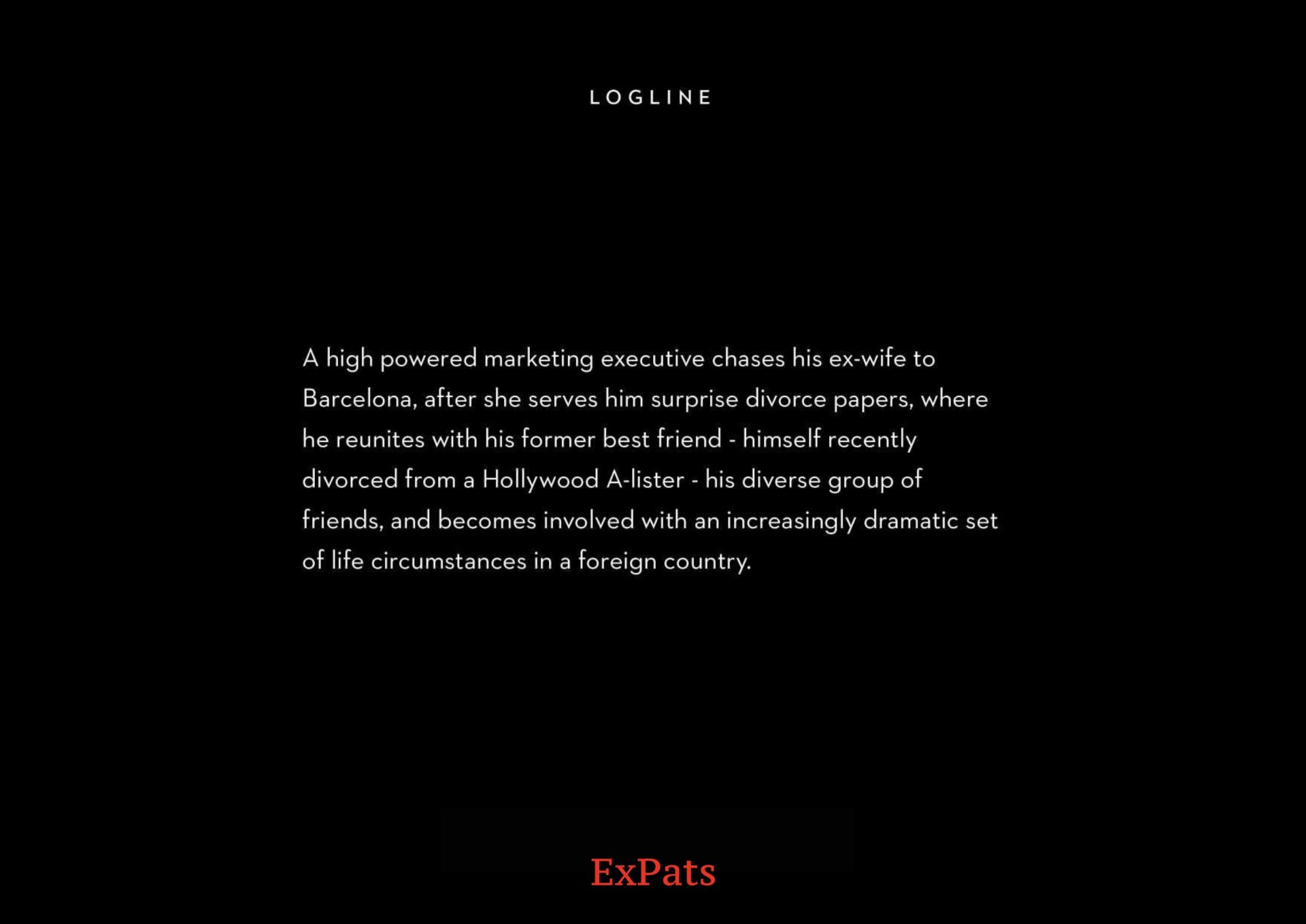
He wrote scripts for a first season of 10 episodes, sketched out story arcs for another four seasons, and even had actors like Richard Sammel (of Inglorious Basterds fame) and Darko Peric (La Casa de Papel) involved – at least if pitch documents are to be believed.
Several months of pre-production work were completed on the project, but as with many of Brown’s previous ventures, ExPats, too, would be riddled with problems.
Haimney owner Matteo says he did roughly three months of pre-production on the show – including location scouting around Barcelona – but wasn’t paid a cent by Brown. By Matteo’s account, that was despite Brown’s assurances of a fixed salary as art director of the project plus a percentage of revenue.
Matteo says that after he confronted Brown, asking to be paid for his time, Brown stopped answering his calls and ultimately left the gallery, never to be heard from again. “He blocked me from everywhere,” Matteo says. “Never said why he was leaving, then disappeared. One week before he was all day with me. It’s kind of weird.”
A two-year working relationship – and friendship – had evaporated overnight.
In late 2022, ExPats was removed from Brown’s “Tim York” profile page on the industry-leading Internet Movie Database (IMDb) website as Brown moved on to his next project.
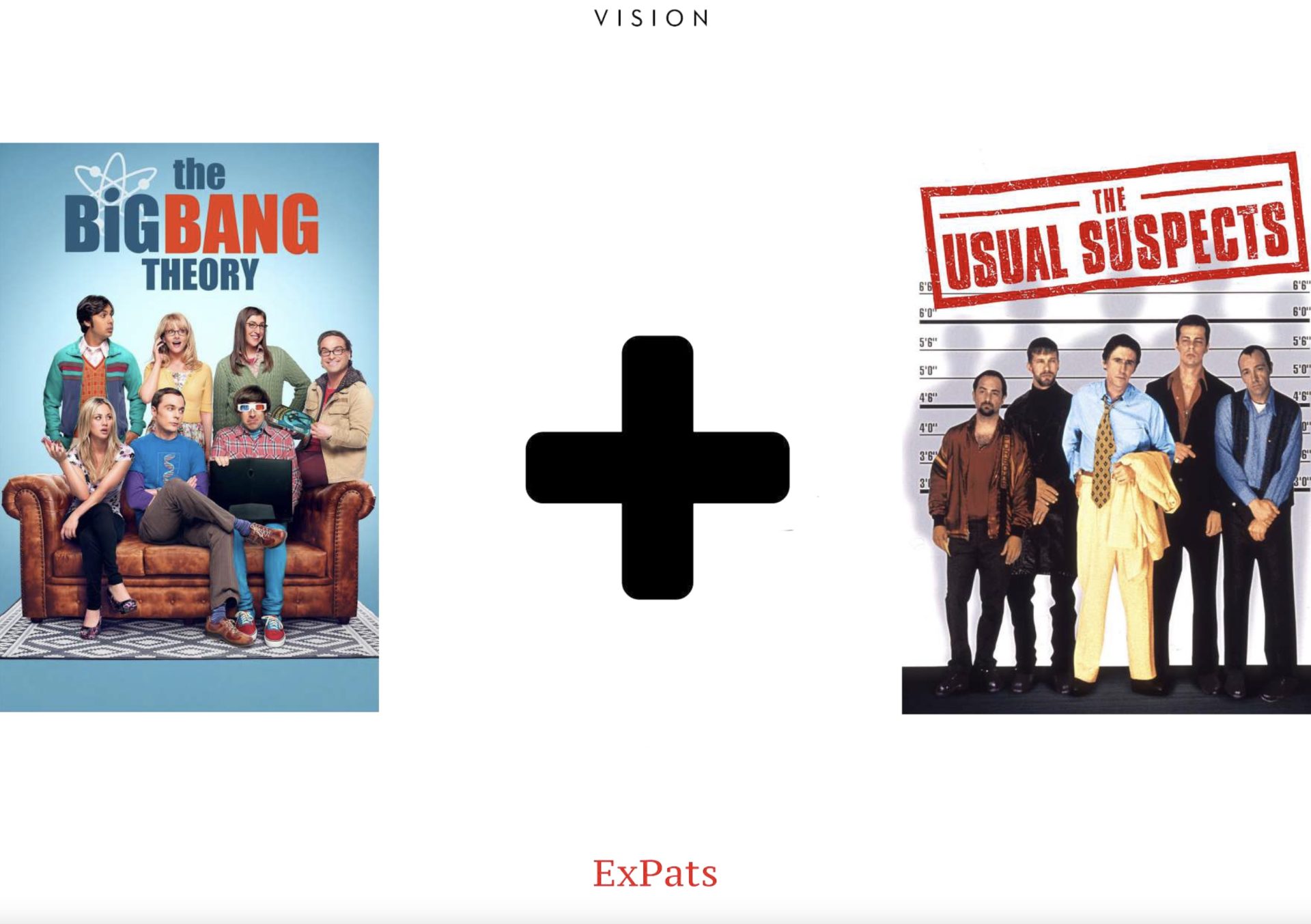
Alex (not their real name) is a film industry professional who spent some time workshopping projects with Brown and who spoke to me on the condition of anonymity. They began their explanation of working with Brown by saying “I wish I’d never met him”.
“I thought he was a bit odd,” Alex says, laughing as we begin our video call. “Full of himself, but very clever, and engaging, and not a bad writer. The scripts weren’t half bad most of the time. Good on character, not so good on plot.
“He had a project, which he asked me to think about collaborating on. So I took some time and I had a read and had further chats and I thought, ‘I suppose there’s nothing to lose. Give it a go.’”
Alex had some early concerns though. Not least the fact “Tim York” was an unknown quantity in the film and television business, given his lack of previously credited work in that arena.
“The excuse I heard was that he had been ghostwriting for people,” Alex says. “He has enough minor celeb friends that that was believable, in some weird way.”
Until late 2022, Tim York’s IMDb profile spoke of 15 years of experience as a ghostwriter and ‘script doctor’ – one who edits and improves scripts prior to shooting. Much like Brown’s claim he’d spent decades working in PR and marketing, this is almost certainly untrue.


Alex and Brown met a couple of times. In describing their relationship with Brown, Alex spoke of something similar to Brown’s former partner at Catalunya Wine, Matthew – Brown accelerating their relationship in an unnatural and uncomfortable way.
“It all became a little bit intense,” Alex says. “Too much contact – it was constant.”
When Alex’s regular work picked back up post-COVID lockdowns, they had less time to spend on Brown’s projects. Brown wasn’t impressed.
“One day, I remember just getting this phone call and him screaming down the phone at me because ‘[You] should fucking leave [your] other job and just focus on this!’ That’s when I think I knew that something was really wrong. Who does that to someone? Especially if you’re asking them for help.”
Things got even scarier when Brown inadvertently revealed his past life to Alex – someone who’d only ever known him as Tim York the screenwriter and producer.
“Eventually, he sent me something, an email one time […] and he’d signed it with another name; it wasn’t Tim York … it was Aaron Brown, which still seems weird to say it,” Alex says, disbelief etched on their face, over a year later. “Honestly, I went a little bit cold and I was like ‘What the fuck is this?’ I was just like, in the middle of the night, on the internet, looking this up and seeing ‘Who is this person? What is this name?’ And then I found some stuff online about the Paul Kimmage thing.
“And then I saw there was something about not paying child support or something else with an ex-wife. And then I saw something about wine culture. One story would be something but three different things in three different countries with the same person?”
After instructing their lawyer to send a “strong letter” to Brown, Alex cut off contact with Brown entirely.
It was clear to me that he didn’t really have much familiarity with the film industry, even though he claimed to have been a ghostwriter on all this shit. Because he always told me ‘In three months, it’s starting …’ I’m like ‘Three months?! What are you talking about? You don’t even have all the funding yet! We don’t have fucking storyboards! There’s so much pre-production prep we need to do! That’s impossible, what you’re saying.”
– Anonymous
At the time of writing, Brown’s “Tim York” IMDb profile currently lists seven films or TV shows he’s working on. Chief among them: two films he wrote and is listed as executive producer for.
Projekt M is a “very dark thriller” in which “a psychologist is requested to assist her former mentor with his unstable daughter and a top secret genetic project”. In September 2021, entertainment news website Hollywood Reporter suggested that Richard Sammel – who’d also been linked to ExPats – was due to play the leading role and Jason Priestley, best known from iconic ‘90s TV show Beverly Hills, 90210, was set to direct the film.
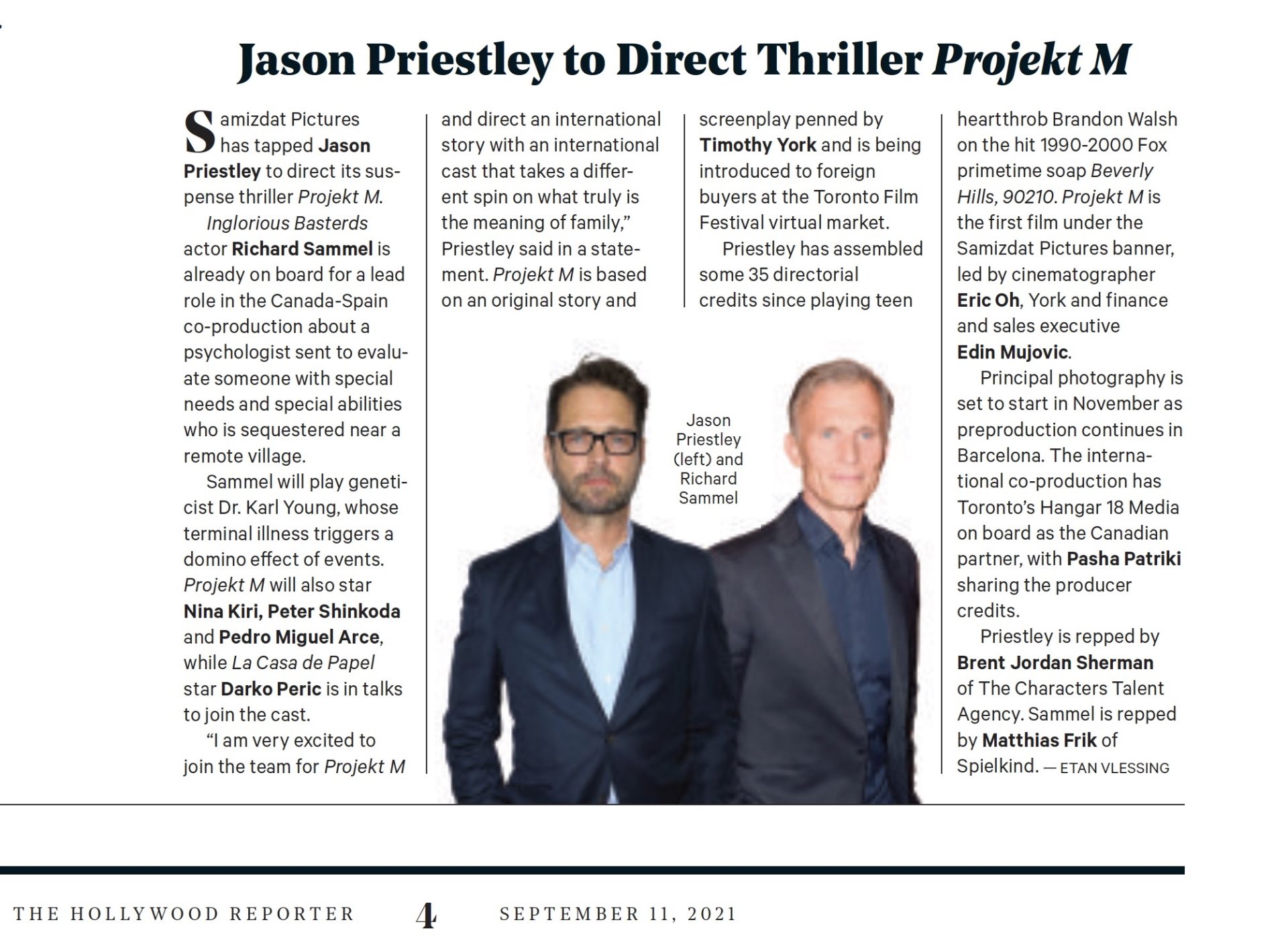
Filming had reportedly been due to begin in early 2021 but has been postponed several times since. Conversations with those in the film’s orbit suggest production on Projekt M has since stalled and that Sammel is no longer involved, if he ever was.
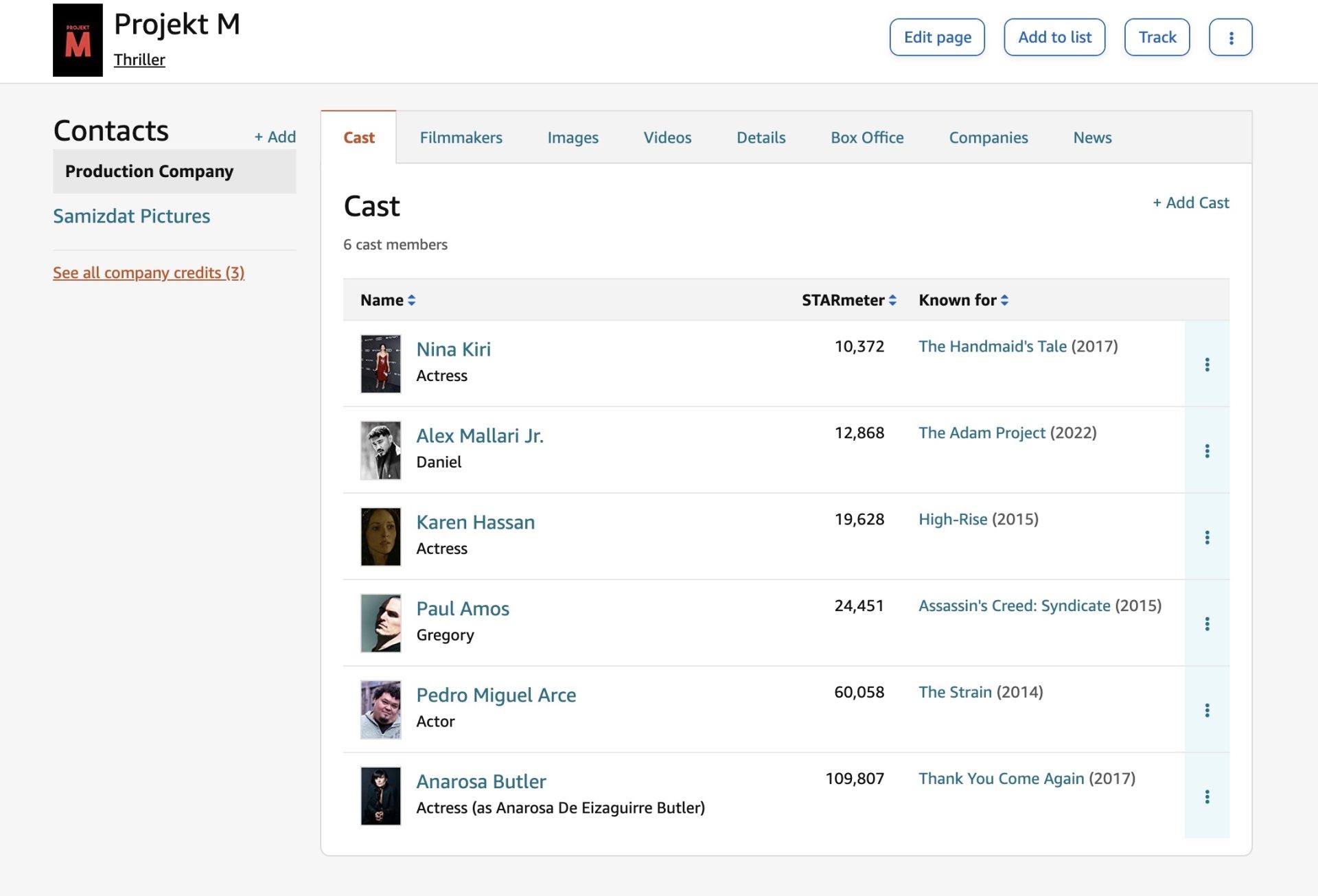
Brown’s second film, Stealing McCloud, tells the story of Marc McCloud, a fictional character inspired by controversial software developer turned entrepreneur John McAfee. Best known as the man behind the anti-virus software bearing his own name, McAfee lived a colourful life in which he fathered 47 children, made two tilts at the US presidency, and had multiple brushes with the law across a range of jurisdictions.
McAfee was arrested in Spain in late 2020 after years of refusing to pay taxes in the US (he’d publicly claimed, on multiple occasions, that taxes are “illegal”). In June 2021, just hours after the Spanish National Court authorised McAfee’s extradition to the US, the 75-year-old was found dead in his prison cell, having apparently died by suicide.
Brown has publicly claimed that McAfee “was a hero of mine” – a curious choice given McAfee’s sordid history.
For Brown’s reimagining of McAfee’s story – in which McCloud is arrested but recruits some friends to help him escape prison – British actor Tim Roth (Reservoir Dogs, Pulp Fiction) was reportedly due to play the titular role. One source tells me that Roth has since pulled out of the project, before adding “if he was ever actually attached to it.”

After production on Projekt M stalled, Brown made significant progress in developing Stealing McCloud. But in shades of Matteo’s experience on ExPats, many on the Stealing McCloud production team invested significant amounts of their own time in the project, without ever being paid.
“It’s all the promise of like, when it gets off the ground, and when [Brown] receives the money, then he can pay them, right?” says one individual with knowledge of the project. “But of course, none of them got paid. But he had location scouting, designing costumes, doing actual work, just hoping that this thing gets off the ground.”
Filming on Stealing McCloud was due to start in April 2022 but has not begun. Sources tell me that, as with Projekt M, it’s unlikely the film will ever be made.
Both Projekt M and Stealing McCloud were being produced under the banner of Samizdat Pictures, a company Brown started in 2020 with Canadian filmmaker Eric Oh. As with Haimney, where Brown traded off the reputation of a respected institution, joining forces with an established industry player in Oh would help give Brown a sense of legitimacy in the world of film. (Oh didn’t respond to multiple requests for an interview).
There are other similarities with Brown’s past projects, too. Just like at Templar Brown and Catalunya Wine, Brown’s face is nowhere to be found when you load up the Samizdat website. In fact the homepage is almost a mirror image of the current-day TemplarBrown.com – a logo, an email address, and that’s it.


Chapter 5: The making of Aaron Brown
Ever since he left the cycling world behind, Aaron Brown has been at pains to keep his past life and image away from the projects he’s working on. But even as @UCI_Overlord on Twitter, and in his time at Cyclismas – where he was happy to appear on camera as Ripp Finklemann – Brown still had an air of mystery about him.
So who is this man who’s moved around the world, changed careers, changed names, and left such a trail of destruction in his wake? In speaking with dozens of people from Brown’s various lives, a picture began to emerge.

Aaron Timothy Brown was born July 24, 1972 in the small Canadian city of Quesnel, British Columbia. An only child who never wanted for anything, Brown spent his childhood in the cities of Vancouver and Victoria (British Columbia) before stints in Edmonton and Calgary (Alberta).
He was born when his mom was 17. They were very successful and so he grew up getting everything he wanted. He was that only child that was the star of the show and always had all the things.
– Jen Ashton, Brown’s ex-wife
Brown would later spend a decade in the US, settling in Portland, Oregon where he found his way into sales roles in the lumber industry. By the early 2000s he’d moved back to Canada to continue his career in the lumber industry, before taking a sideways step into the world of new home sales.
Brown left that industry in October 2006 and tried his hand as an entrepreneur. He opened two café businesses: the first, San Carlos Caffee in Okotoks, Alberta, just south of Calgary; the second, the aforementioned Wildwood Cafe in Bridgewater, Nova Scotia, on the other side of the country. It was during his time at Wildwood Cafe that Brown started edging his way into the cycling scene.
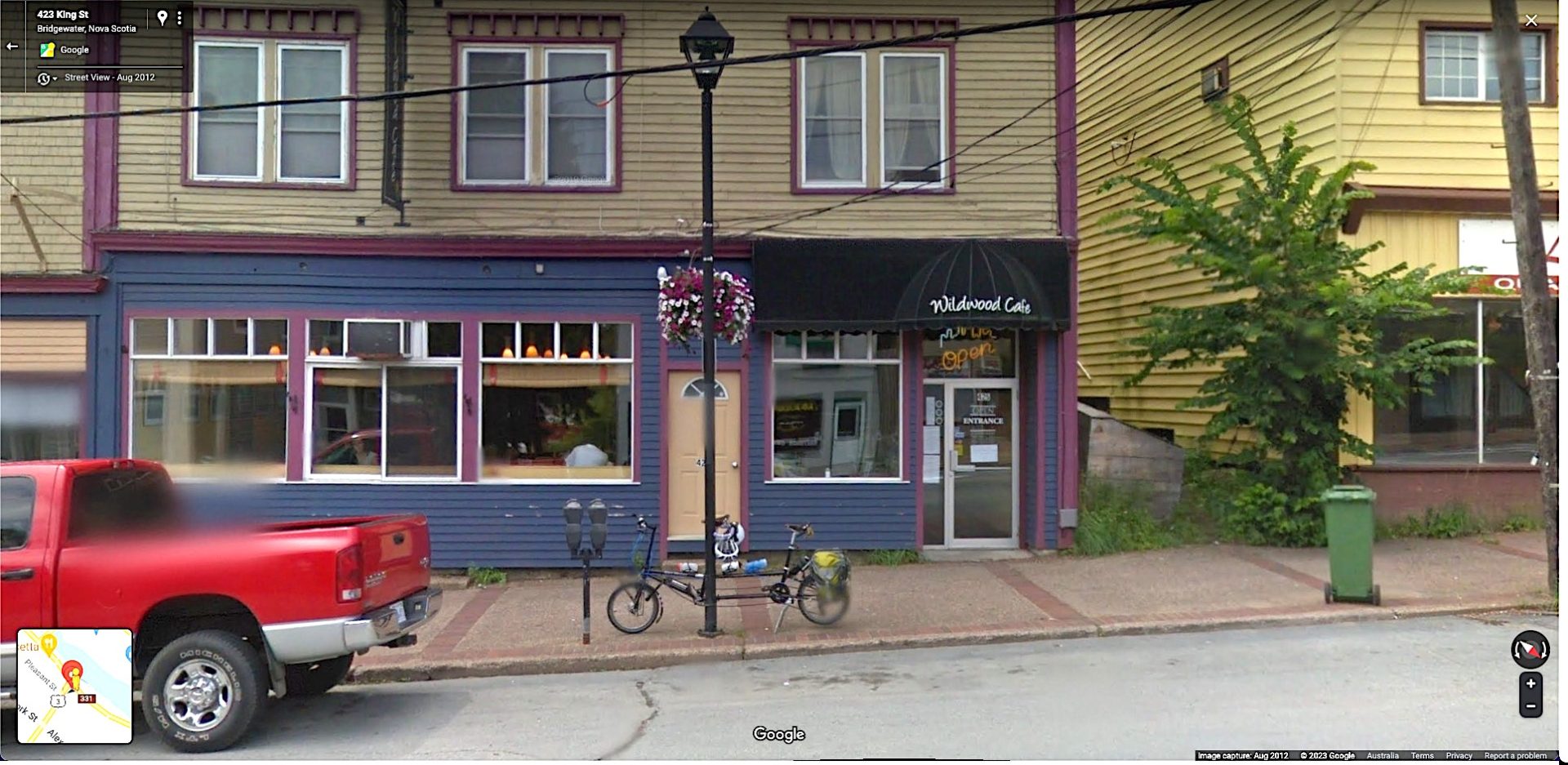
Many I spoke to described Brown as a handsome, well-dressed individual with seemingly unshakeable confidence in himself. The sort of person who has no problem walking across a room to introduce himself to a stranger.
Many were quick to highlight Brown’s considerable intelligence. Several individuals, all of whom had been hurt by Brown in some way, described him as a “genius”. They highlighted his near-photographic memory, wide breadth of knowledge, his ability to work with tremendous speed, and the fact he’s a remarkably quick study, able to pick up and retain new information with great ease – a useful skill for someone who has a history of personal reinvention and whose work has spanned such a variety of industries.
These personal metamorphoses are something Brown seems to have embraced about himself, too. In a radio interview in 2017, Brown described himself as “one of those guys with a short attention span”. And in the bio for his now-deleted Tim York Instagram account, Brown called himself (among other things) a “saltationist” – one who makes sudden and very large changes from one generation to the next.

Many people I spoke with described Brown as impressively well connected. Among them, Jaimie Fuller, former CEO of compression-wear company Skins. While Fuller has few nice words to say about Brown today, he is complimentary of the way Brown helped connect him with those who would appear at an anti-doping conference Fuller once organised.
“Aaron was helpful, supportive, gave me advice,” Fuller tells me. “He was a very strong conduit to what I described as the underworld of cycling culture. I had no negative interaction with him, he didn’t fuck me over, he didn’t rip me off – there was none of that. He was absolutely a positive influence on where I went and what I did and how I did it.”
Several people, though, felt that Brown used them to get access to their contacts, or that he exploited his network in other ways.
One acquaintance of Brown’s in the screen industry recalls watching Brown pull people into his film projects, by raving about those who were already involved (or who he claimed were involved). Like Richard Sammel, or Tim Roth, say. “It’s like this whole web, where he gets leverage by association,” the source says.
Brown’s movements in the world of film and TV fit with something said to me by Jen Ashton, Brown’s ex-wife from before his relationship with Gallardo: Brown feels a need to associate himself with successful, if not famous, people.
“He wants to be a high-roller,” she tells me. “If you see the circles that he rolls around [in] … he has to keep up with the Joneses more than anybody I’ve ever met in my life.”

Almost everyone I spoke to highlighted Brown’s charming, charismatic nature – the fact he is frequently smiling, always ready to listen, and very easy to get along with.
“He looks directly at you, he makes good eye contact, he listens to you, and he is really kind,” says the hospitality professional from Barcelona. “He talks about his wife [Lisandra], and he’s super excited to talk about [their] kids – he lets you into his world a little bit.”
That hospitality worker says she often felt like Brown genuinely wanted to help those around him.
“If you were having a bad day, he’d be like, ‘Oh, what’s going on? Is everything OK?’” she recalls. “He’d read you and then he would [say] ‘Well, let me know if I can help you with any of that …’”
Given these traits, it’s little surprise many describe Brown as a talented salesman. A former colleague of Brown’s in the new-home-sales industry says Brown has “the gift of the gab” while Ashton says “he can get anybody to believe anything he wants [them] to believe.”
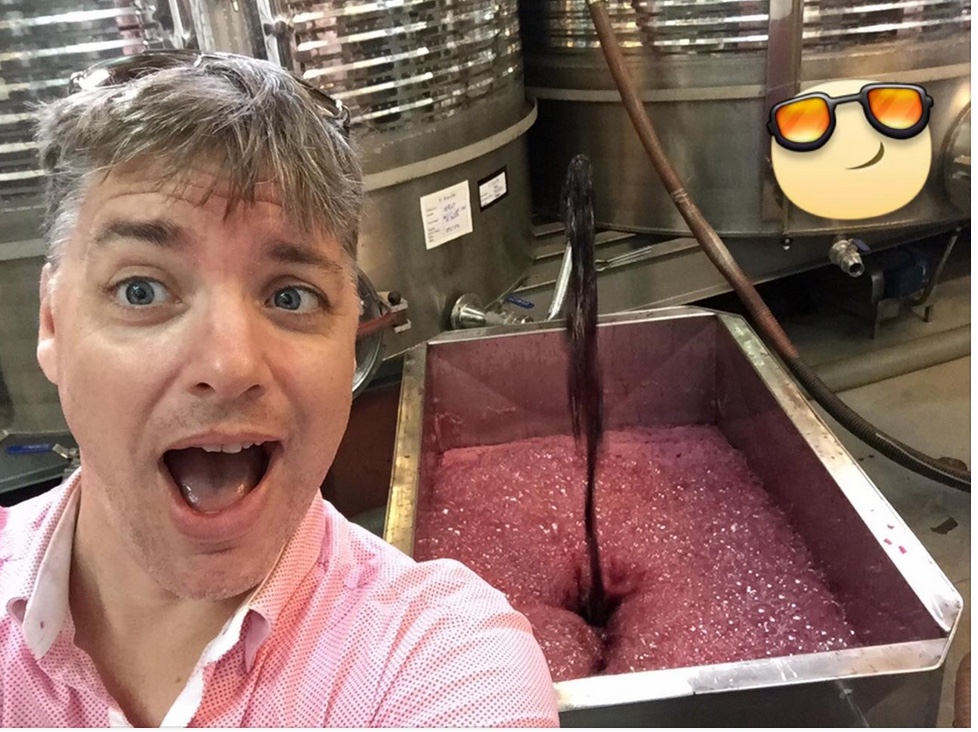
But not everyone is convinced by Brown’s charm. To some it comes across as hokey, manipulative, and unsettling.
“He was too smooth,” says one former colleague, who wanted to remain anonymous. “He always had this way of trying to charm you, and it made me want to throw up. It’s that feeling you get – hair standing up, like ‘something’s not right with this guy.’” Another said it was like Brown was “poking his finger in my soul, looking to see what angle he could use with me.”
While a handful of people saw the warning signs right away, others weren’t so lucky. To them, Brown made grand promises to help out however he could, before ultimately falling well short.
Like Justin Pickens, the Cyclismas employee who followed Brown from Canada to Spain, only for his promised job to fall apart in a few short months. Or the four Catalan wineries who were promised a documentary film that never eventuated. Or David Carson who was promised a book of his new artwork, which was only made because the project was eventually wrestled from Brown’s control. Or Matteo, the owner of the Haimney gallery, who feels Brown promised to help grow his business, and make him money through the ExPats project, but ultimately did neither.
“He was sweetening my ears all the time,” Matteo says. “The terrible thing is that he kind of knows what your aspiration is and he works with your aspiration and your dreams to fuck you. It’s really something shocking in a way.”
[Brown] has that kind of face that will drag you into his lies. He would be a great actor.
– Anonymous
While Brown is charming and charismatic to begin with, when things go bad, he’s quick to blame others. Audio recordings of Brown around the time of the Kimmage Fund drama paint a picture of a defiant and stubborn individual who’s seemingly unable to accept responsibility for his own mistakes. In the words of the artist David Carson, Brown “would never admit any fault in anything. No matter how small. Never.”
And when things fall apart, Brown angers easily, lashing out at those around him. One film industry professional spoke with incredulity about the way Brown would immediately turn on those he’d built relationships with, if he felt they’d slighted him. Multiple emails and audio and video recordings of Brown over the years also reveal an individual willing to gaslight and manipulate those he’s speaking to, twisting the truth to suit his purposes.
Many conversations with those in Brown’s various orbits revealed patterns around financial matters too. “The money is coming” was something many people heard from Brown, but often it wasn’t. It was a refrain Brown used repeatedly when responding to questions about the whereabouts of the Kimmage Fund, likewise when it came to salary payments he owed Pickens at Cyclismas, Matthew at Catalunya Wine, and those working on his films.
Matthew even recalls a similar experience when they lived together in Girona. “I would be home and the landlord would come over – ‘Where’s the rent?’ And I’d be like ‘I don’t know anything about that,’” he says. “‘I pay my portion of the rent to Aaron; I assume he pays you.’ And he’s like ‘No, that’s not what’s going on.’”
Brown had an explanation: “He was like ‘Oh, don’t worry, I’ve already talked to him. We made a payment arrangement,’” Matthew says. “It was good lies to buy himself time, and eventually he moved out of there.”

Lesli Cohen, Brown’s business partner at Cyclismas, recalls another instance of Brown’s financial dishonesty, right before the Kimmage Fund saga exploded. The Cyclismas team had been in England for a video shoot for a collaborative project with bike brand Trek. As Cohen recalls, Brown told everyone he had to leave early on the morning after the film shoot wrapped, before anyone else. The plan had been for Brown to pay for the hotel using Cyclismas funds.
“So he flies back early and when Chris [Garrison, from Trek] and I go to check out we discover that nothing’s been paid for,” Cohen recalls. “So Chris from Trek picked up the tab saying that she would settle up later, because I didn’t have the company credit card – Aaron did.”
Garrison says it was worse than that; that the hotel bill was just the start.
The invoice Brown sent to Garrison for the collaboration didn’t mention Cyclismas at all – it was made out to Siroque Holdings, Brown’s company. Once the invoice was paid, Garrison says, Brown stopped responding to communication. He held onto the hard drives Trek had provided for the video footage – both the drives and the footage were property of Trek – ultimately forcing Garrison to pull the plug on the whole project.
And the £10,000 Trek paid Cyclismas for the collaboration? According to Garrison, that remained under Brown’s sole control, just like the Kimmage Fund.
Brown’s difficult relationship with money long pre-dates 2013 and his troubles in the cycling world.
Before moving to Girona in late 2012, Brown and his then-partner Maria Gallardo ran the Wildwood Cafe in Bridgewater, Nova Scotia, Canada. After opening in February 2009, Wildwood became a popular and well-regarded café, but it would ultimately close in inglorious circumstances.
The Nova Scotia Registry of Joint Stock Companies shows the cafe’s business registration was revoked for non-payment in August 2010 and wasn’t renewed. A couple years later, the Canada Revenue Agency notified Gallardo (the cafe’s registered owner) of a tax debt ultimately worth around CA$70,000. The couple packed up and moved with their young son to Girona a few months later. (While Brown described the move as being for the benefit of Cyclismas, it’s relevant to note that Spain has a reputation for being friendly to those pursued by authorities back home.)
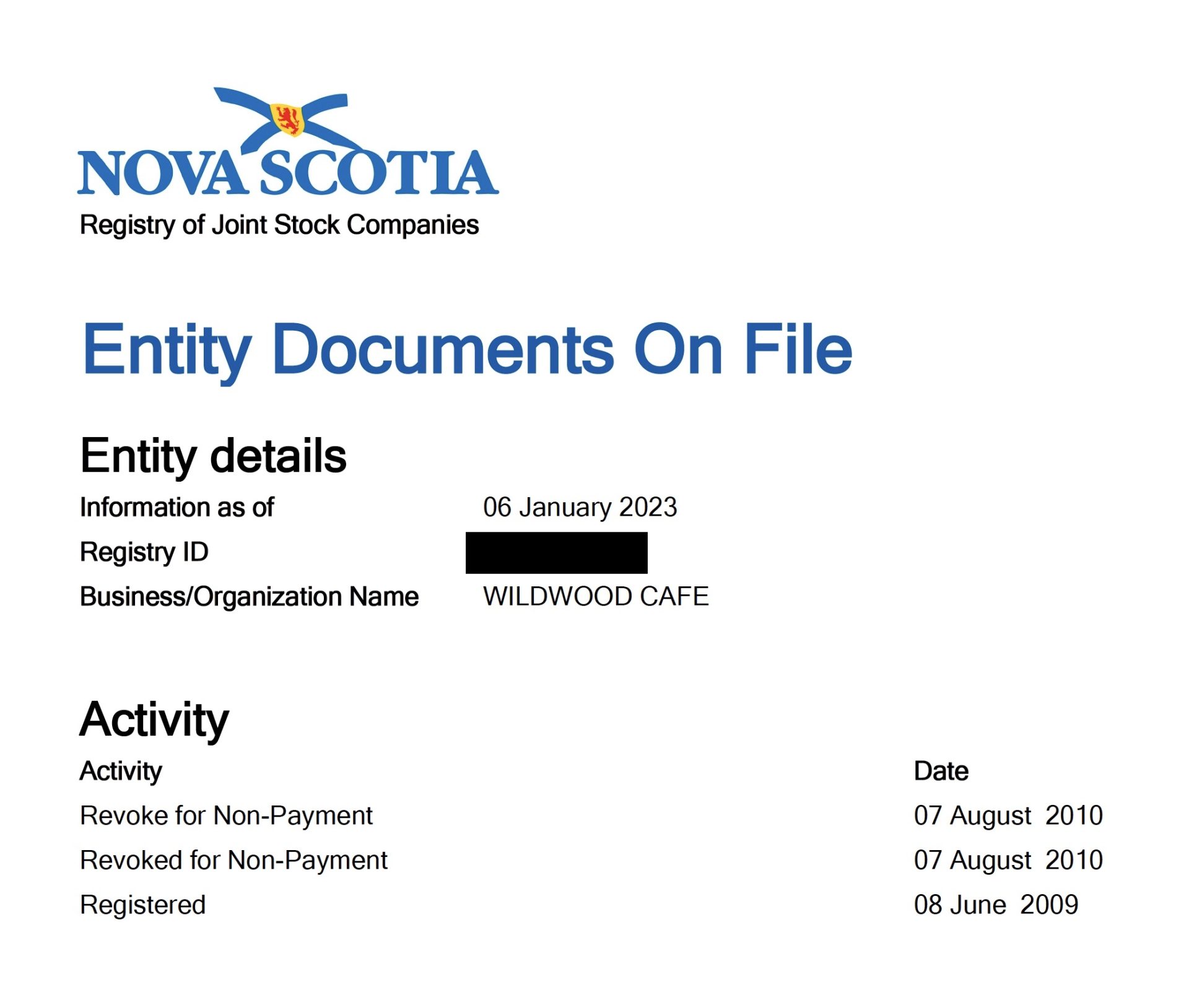
Brown’s previous venture was also mired by financial problems. San Carlos Caffee, the café in Okotoks, Alberta, bounced five checks to employees around the time Brown was trying to sell it in late 2008. Meanwhile, one vendor who’d been a supplier for San Carlos Caffee described themselves as “one of a litany of people affected by the financial non-compliance of one Aaron Brown”, saying that Brown owed them around CA$800 for services rendered. In 2011, Brown admitted to government officials that he left the business with debts only “partially retired”.
And Brown’s financial woes weren’t constrained to his business interests. His ex-wife Jen Ashton tells the story of a relatively minor misstep that paved the way for bigger indiscretions in future; an incident that occurred just as their marriage was starting to fall apart.
“He had sold this pair of rollerblades on eBay,” she recalls. “He accepted the money, those rollerblades sat there and sat there and sat there. And I was like, ‘Aren’t you going to send these? That’s like stealing from this guy.’ And he never did. He changed his profile. And he would continue to sell different stuff with a different profile.”
Ashton soon learnt that Brown was capable of much larger errors of judgement; ones that would impact her directly. Official records from the Nova Scotia Department of Justice show that by 2011, three years after Brown and Ashton’s divorce, Brown owed more than CA$77,000 in unpaid child support.
Brown’s passport and driver’s license were eventually cancelled due to his non-compliance and at one stage, Ashton explains, Brown was even about to be arrested for failing to meet his obligations. That was in 2012, once Brown and Gallardo had long left Alberta behind, moved across the country, and established themselves in Nova Scotia.
“I had just written a letter to Nova Scotia Maintenance Enforcement because they were not connecting the dots with Alberta for whatever reason,” Ashton recalls. “And then they quickly were like, ‘Oh my god,’ so they then jumped on it, and did try to take some action. In order to not go to jail he had to pay $20,000 … that came from his mom.”
Ashton explains that with that lump sum paid, Brown was able to get a new passport issued in January 2013, at which point he, Gallardo, and their son left Canada for Spain. Brown had done just enough to be able to get out of the country and leave his obligations behind. Brown’s passport was suspended by the Canadian government again six months later, in July 2013.
Brown made his last child support payment in late April 2013. While his and Ashton’s two children are now adults and Brown’s child support debt has stopped growing, the debt still exists. As of early 2023, his total liability remains at CA$82,599.94.
He was avidly trying to avoid paying any child support. And even though I did everything in my power, and the government did everything in their power …
– Jen Ashton
Which brings us back to the Kimmage Fund.
In October 2014, 18 months after Cohen discovered Brown had moved the remainder of the Kimmage Fund into an account under his sole control, the Massachusetts Superior Court found Brown liable for the missing money. Brown didn’t turn up to the ‘final damage trial’ in early January 2015, and when a final judgment was handed down in February 2015 the outcome was damning.
Brown was ordered to pay US$84,580.25 to Bill Hue as representative of the donors (the US$69,935 that remained of the Kimmage Fund plus interest between October 2013 and January 2015). As Hue explains, that amount means Brown was found liable for everything left in the fund before he started sending out refunds.
“Because he did not cooperate as required by law it was impossible for us to know exactly who he claimed he sent refunds to,” Hue tells me. “Ultimately the court granted judgment for the entire amount because any reduction in funds he retained due to claimed ‘refunds’ could not be confirmed.”
(Earlier in proceedings, Brown was also held in contempt of court for sending out refunds despite the court ordering him specifically not to do so.)
To sum up, Brown lost on procedure. He lost on the merits. He lost as much as he could possibly lose. He failed to appeal. He failed miserably and completely. The legal matter and any arguments Brown once had are over and closed. Each and every argument has been decided against him by a neutral court of law.
– Bill Hue, on the court judgment against Brown.
Sadly, for anyone still holding out hope of getting their donation back, the Massachusetts court system has no ability to collect Brown’s debt so long as he remains in Spain.
“Outside the US the ability to collect judgments is set by something called the Hague Convention,” Hue told CyclingTips.com back in 2015. “I won’t pretend to be optimistic about getting this money back but it was very important to have a court of law recognise our loss [and] the person responsible for our loss.”
(As Hue told me recently, though, if Brown was ever to re-enter the US, Hue might have some recourse to claim the funds owed. “If he has any collectible assets in the United States”.)
In the case of the Cyclismas business dispute, the Massachusetts court ordered Brown to pay Cohen a total of US$46,862.06. That total included the nearly US$6,000 Cohen pitched in to set up Cyclismas (Brown contributed $0 according to the court judgment), plus Cohen’s half of the money Cyclismas had earned through its business dealings (such as partnerships with Trek and other brands.) The court judgment also noted that Brown had “disbursed Cyclismas funds of US$43,698.20 for unauthorized nonpartnership purposes”, like travel expenses, car rentals and entertainment for himself. Brown’s $2 million defamation countersuit against Cohen was also dismissed.
Under Massachusetts law, Brown’s debts to Hue and Cohen have both been gaining interest at a rate of 12% per year since the judgment was handed down. At the time of writing, Brown’s debt in the case of the Kimmage Fund amounts to more than US$220,000. His debt to Lesli Cohen now stands at more than US$120,000.
Add up all of Brown’s grifts and unpaid debts over the past 15 years and that total is considerably higher. A rough calculation suggests a figure in the realm of US$500,000, spread across at least three countries.
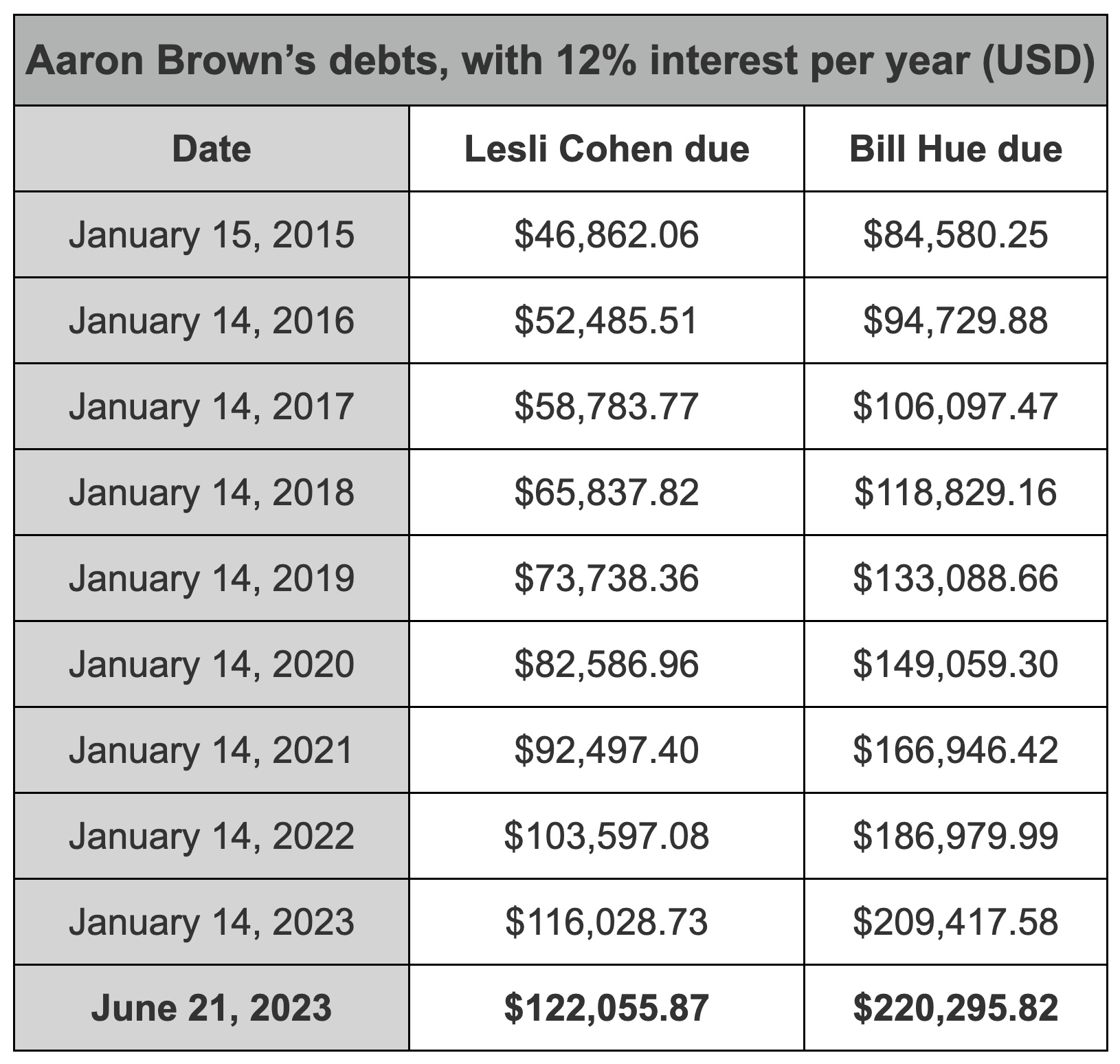
So what can we make of Brown’s history of financial woes? Do they suggest a pattern of trying to make money – or hold on to it – by whatever means necessary, regardless of his ethical and legal obligations, and regardless of the cost to others?
Throughout the course of this investigation, multiple people, all speaking independently of one another, said they felt they’d been conned by Brown. Matthew, Brown’s former business partner and roommate, offered this assessment: “If he did take the [Kimmage] Defence Fund, that’s not a good person who finds themselves in a bad situation. That’s a bad person who makes a bad decision.”
Whatever Brown’s motivations might be, it’s clear from speaking with his former colleagues and associates that he has long history of over-exaggeration, distorting the truth, and even outright deception.
As previously noted, Brown’s descriptions of his work history show a propensity for outright lies. His various bios on CatalunyaWine.com, written in the mid-2010s, which describe Brown as having “spent 15 years in the corporate management ranks in the realms of marketing, advertising, and public relations”? They’re an absolute fabrication, according to Ashton.
She explains that Brown’s first notable job was at a home improvement store before he moved into the lumber sales business and eventually into new-home sales. “As long as I was with him, there was no PR and marketing,” she says. Ashton’s claim is backed up by Brown’s official correspondence with government officials in Nova Scotia in December 2009, in which he wrote “I have been in sales my entire career”.
Brown and Ashton divorced in January 2008. It wasn’t until several years later, when he was trying to grow Cyclismas, that Brown spent any real time working in PR and marketing.
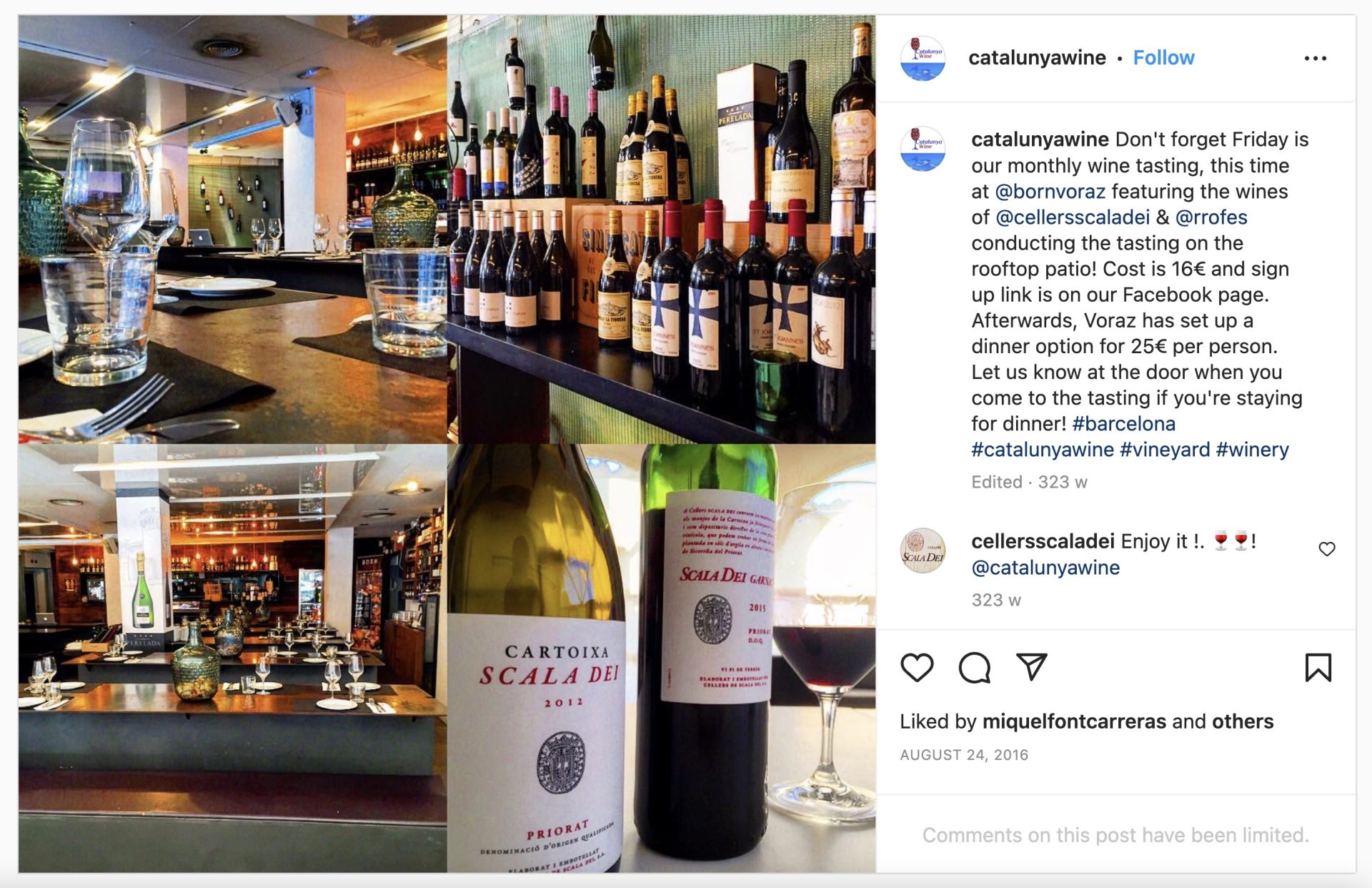
Brown even has a history of misrepresenting his cycling ability. Matthew recalls one particular moment back in the Catalunya Wine days where the pair rode to a winery.
“He used to talk about his cycling prowess – ‘I could have gone pro’, that kind of attitude, you know?” Matthew says. “We were going to bike from the train station to the vineyard. And obviously there’s a climb involved in that. It was warm, but it wasn’t unbearably hot on that day. And Aaron couldn’t do it. He couldn’t finish it. He actually had to stop twice. And on the second time, he vomited.”
Matthew smiles broadly as he recounts the story.
“I am not a cyclist. I do the treadmill. I do a stationary bike and stuff like that. I made the climb and I stopped for him when he’d stopped and I’d look back – ‘Are you OK? All right. I’ll see you at the [top of the] hill.’ And then finally, still short of the top of the climb, there he is puking on the side of the road.
“At that point you’re like ‘He’s lost a lot of shape!’ It wasn’t like he was overweight or anything, but he had no fucking endurance for a guy who used to be a cyclist.”
Matthew isn’t the only one with such a story. Brown had also tried to convince Paul Kimmage that he’d been a “crack amateur” – a story that fell apart when the pair rode the legendary Rocacorba climb near Girona. “[Brown] was 45 minutes, maybe an hour behind me at the top,” Kimmage told journalist Joe Lindsey in 2013. “He didn’t seem like a person who’d ridden in his life.”
Ashton says there’s a good reason for that.
“From the time I met him when we were both 21 years old [in 1993], until the time we separated [in the late 2000s], he did not cycle at all,” she says. “The only bike he ever had … we had mountain bikes as a family, and we would just ride the streets. He was not a cyclist.”
Ashton says Brown told a similar lie when it came to his ice hockey background.
“The night I met him, he told me he was a hockey player and that he was on a WHL [Western Hockey League] team,” Ashton recalls. “He absolutely was not. But then in the group of hockey dads he would say ‘Oh yeah, I used to play AAA’ [the highest level of junior hockey in Canada – ed.] He didn’t play hockey as a kid. His parents were very … that wasn’t their jam.
“The first time there was a parents vs kids hockey game he was out there and the dads were like, ‘Oh, yeah, he didn’t play hockey.’”
While Brown is no stranger to a bald-faced lie, in many cases his deceptions exist in grey areas. Squint hard enough and his explanations might just make sense, or contain some kernel of truth.
In the case of David Carson’s book, maybe Brown did need some costs covered, and so keeping the pre-order money made sense. With the conference flights for the wine website, perhaps Brown did send some articles that weren’t published. In the case of the wine documentary, maybe he had been publicising the wineries on social media and his website and so, in his mind, keeping the money was justified on some level.
Indeed, zoom in to each individual case and you could be forgiven for chalking up any drama to things just not working out. But it’s when you zoom out and take in the bigger picture – a picture that involves many such cases – that the image becomes clearer; that this is more than a case of “things just didn’t work out.”
“The guy, I think, has no sense of dignity,” says Matteo, the gallery owner. “The problem with him is that when things go bad, he’s going to fuck you. He’s not going to be honest about it.”
All of these little deceptions, these failed partnerships – they all have a cost, even if the dollar amounts involved are small. Indeed, even if there is no money involved at all, there’s a human cost that needs to be accounted for.
Chapter 6: The trail of damage
From many conversations with those in Brown’s past, it’s clear he’s left a long list of angry, confused, and hurt individuals behind him. Prominent among them: Lesli Cohen, Brown’s former business partner at Cyclismas. She’s doing well these days, a decade later, but in the immediate aftermath of the Kimmage Fund disaster, it was a different story.
“I was a fucking wreck,” she says. “I didn’t sleep, I lost like 20 pounds (9 kg), I was sick. I was either drinking or crying, or apologising, and reading online forums about how stupid and gullible I was. It was devastating. I was mortified. I didn’t want to show my face in cycling.
“I think my husband spent probably US$85,000 in legal fees for us to try to make good for the Kimmage Fund and to get the Cyclismas money back. And we didn’t get it back.”
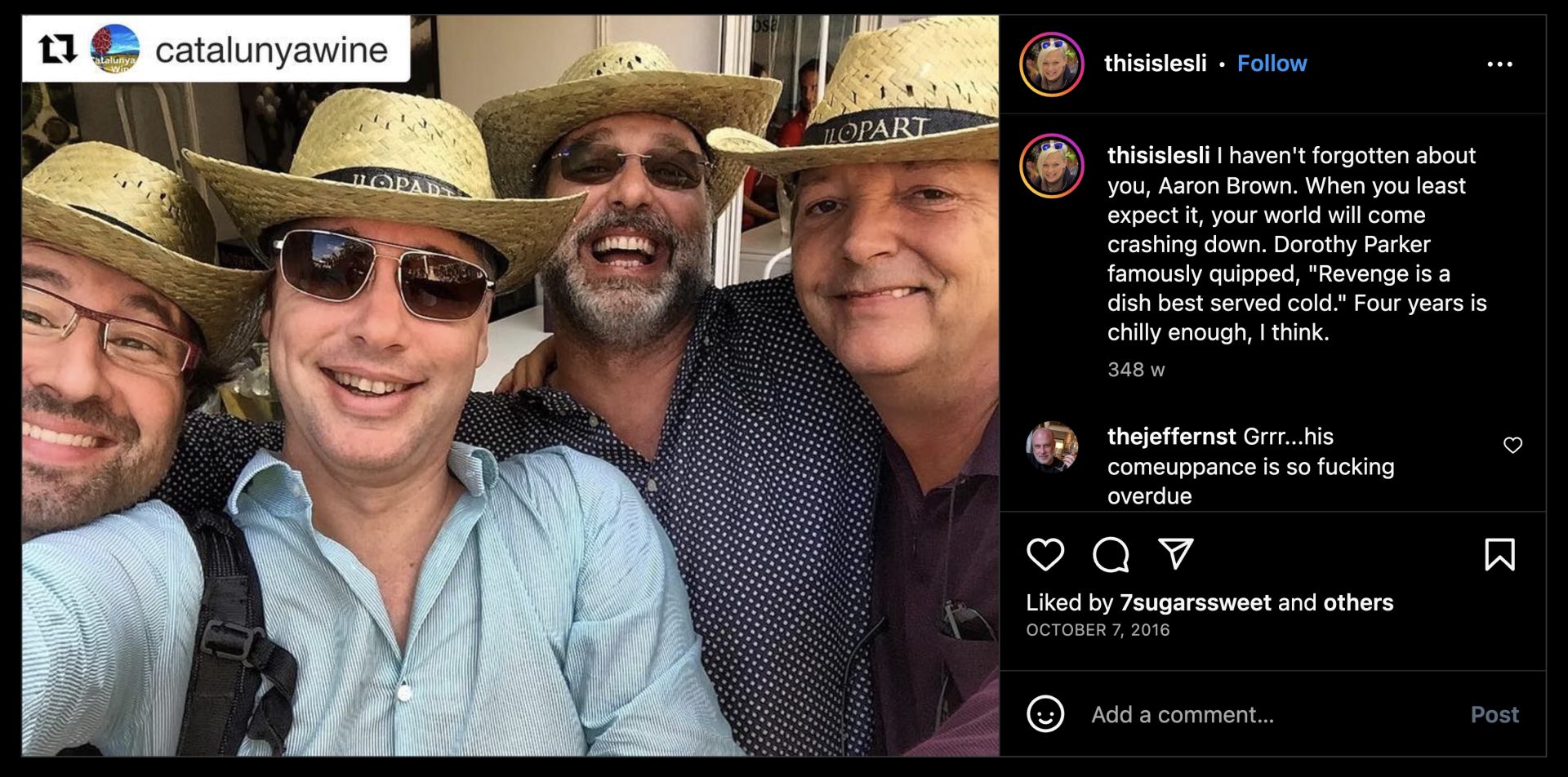
Paul Kimmage, too, winces when he thinks back to that time.
“I thought I was a good judge of character but he bought and sold me,” he tells me. “I was absolutely, completely suckered. Terrible feeling to be suckered, you know? It was a valuable lesson for me. A sobering, sobering lesson.”
Many people I contacted for this story didn’t want to speak about Brown at all. Others only spoke on the condition that their name wasn’t linked with Brown’s in any way. One individual from the wine industry said they considered Brown a friend but cut ties after learning about Brown’s role in the Kimmage Fund saga.
“I’d rather just forget about that person and the time we had dealings,” they tell me. “Because of his dishonesty and rather strange business ways, I have had some professional challenges within the wine world. And this is the sector I am making my living from.”
For many, there’s a feeling of embarrassment at having been duped or scammed; for having been swayed by Brown’s charisma, and not seeing his true colours earlier. Like the film industry professional, Alex, who inadvertently learned about Brown’s different personas. They described feeling “stupid”, and “embarrassed” at having believed “Tim York” was who he said he was.
That same person felt their interactions with Brown had even shaken their ability to trust others in future. “After my awful experience with Tim, it is very hard to trust anything that anyone says,” Alex tells me. Indeed, they only agreed to speak for this story after I confirmed my identity by sending scans of my official identity documents.
Others I spoke to felt betrayed by Brown on a deeply personal level. They felt as if he was their friend, but when push came to shove, it was clear that wasn’t the case.
“At one time I wanted to think he was my friend, but I don’t think he ever was,” Cohen says. “I think it was really convenience more than anything. He seems genuine enough when you talk to him, but he’s also a really good actor.”
“This guy at one point referred to me as his brother,” Matthew says. “I was never his friend. I was a mark and I was a face to hide behind. I guess if he’s got the capacity to walk away from his real family, walking away from me was nothing.”
Ashton recalls how easy it was for Brown to put his past behind him when he left her for Gallardo.
“When they [Brown and Gallardo] had the restaurant [San Carlos Caffee in Okotoks], he took on a whole different persona in the town he lived in – in the town that our children were playing hockey [in]; in the town that our children went to the school [in],” she tells me. “He was saying that he just moved here [to Okotoks]. He and [Maria] had made this whole other persona. It was wild.”
Ashton says that much of the pain from her time with Brown has receded, but it’s clear she’s still in disbelief about his behaviour.
“He didn’t acknowledge that he had other kids,” she continues. As we speak, four photos of her and the two kids she had with Brown are visible on a shelf behind her. She tells the story of those kids visiting a family friend who lived across the road from Brown and Gallardo, in the years after Brown and Ashton separated.
“They were having a garage sale, probably the weekend before they actually left [Alberta for Nova Scotia],” Ashton recalls. “My kids … were in the cul de sac playing street hockey, and [Brown] didn’t acknowledge them. And he was selling their stuff! And they were like, ‘What is going on here?’
“It was super easy [for Brown to walk away from his kids]. He had already separated from them in his mind.”
***
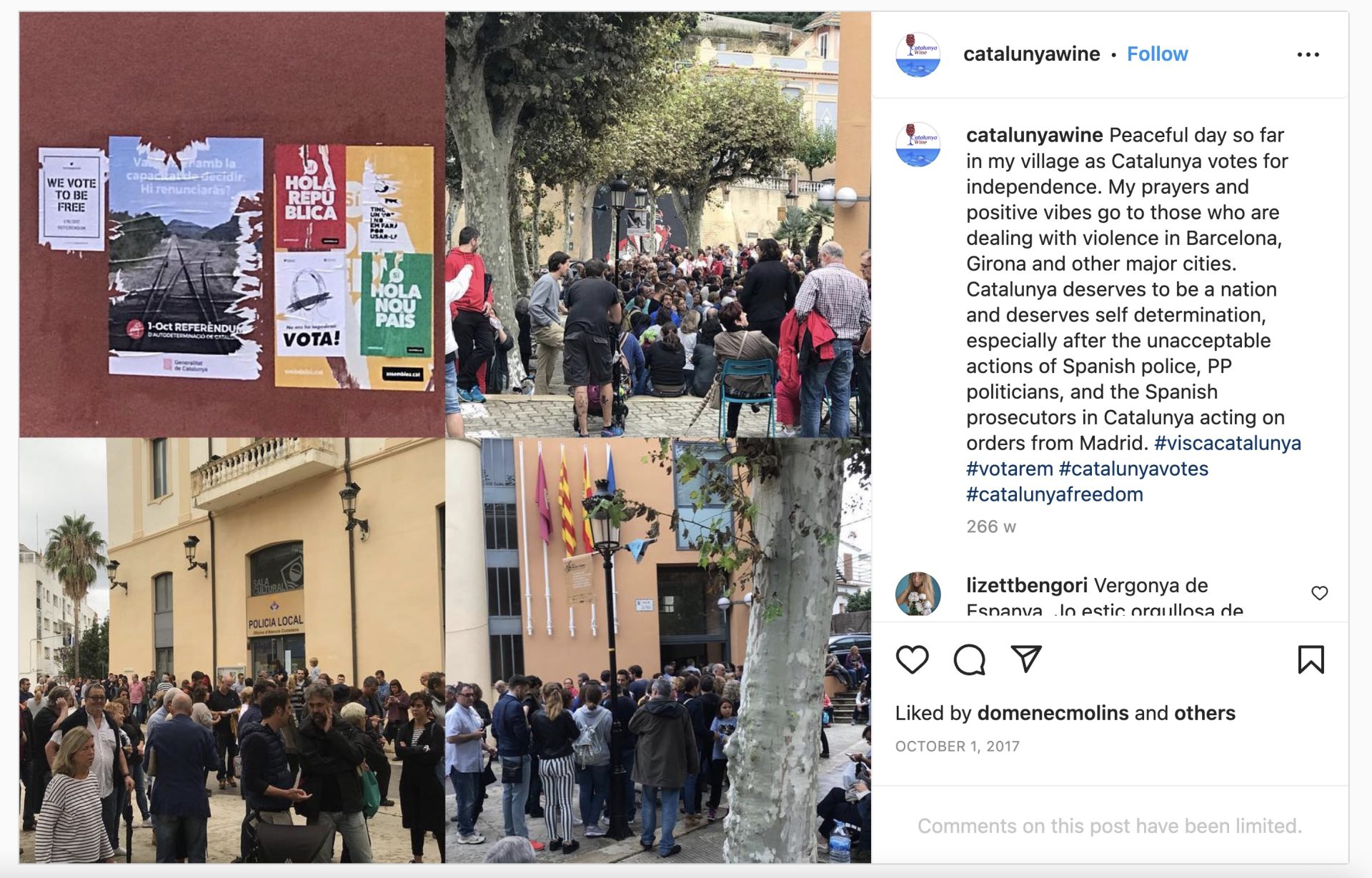
It’s been a little over a decade since Aaron Timothy Brown left Canada for Spain, pocketed what remained of the Paul Kimmage Defence Fund, and turned his back on the cycling world for good. In those 10 years the now-50-year-old has reinvented himself several times, gone by multiple different names, and tried to forge a career in several different spheres.
While Brown has been at pains to cover his tracks in the past decade, remnants of his past lives linger online. At the time of writing, CatalunyaWine.com still exists; so too do its Facebook, Twitter, and Instagram accounts. In fact, in November 2022, the last of those even teased the idea of a return for Catalunya Wine, although nothing seems to have eventuated as yet.
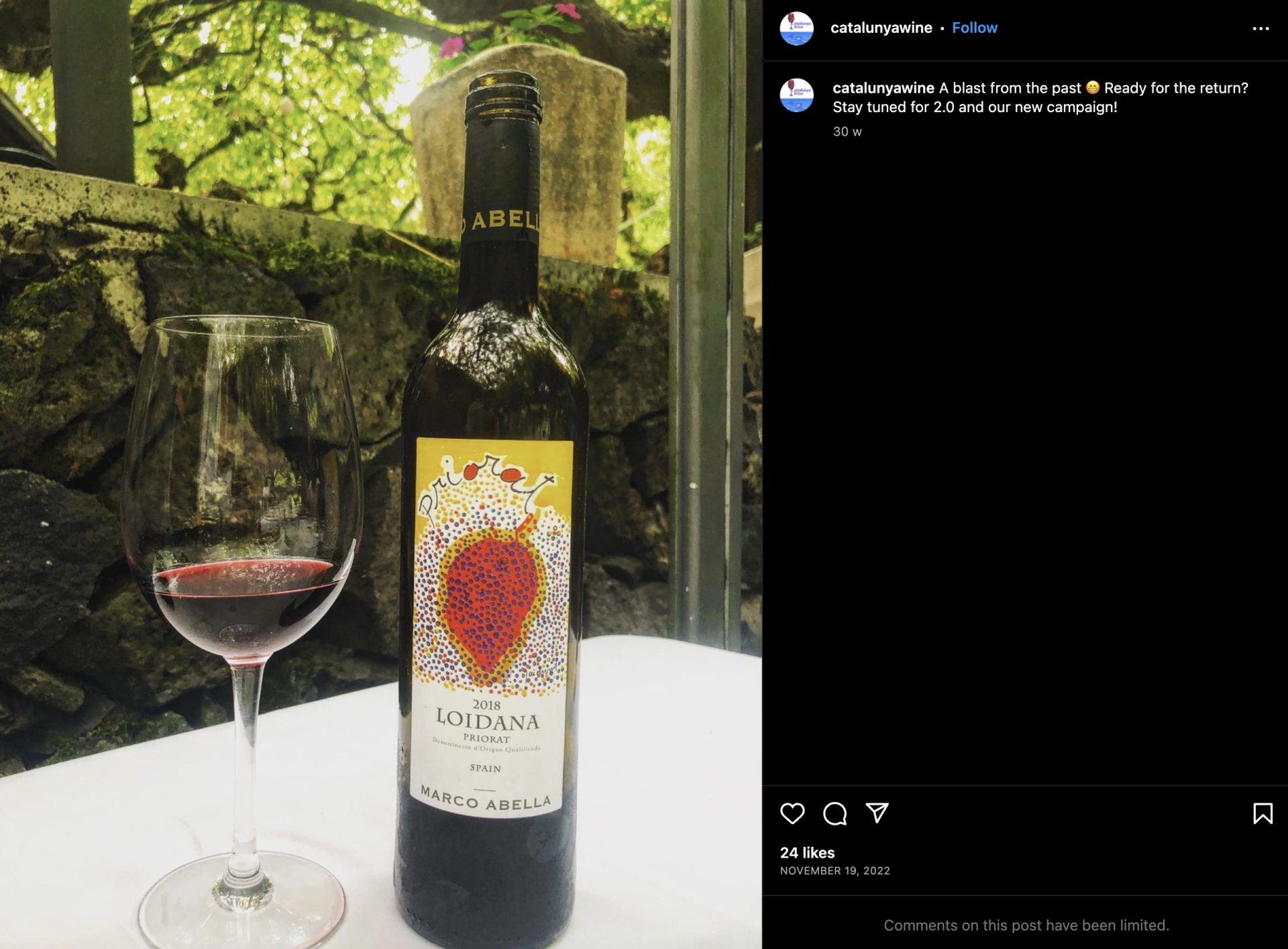
The Kimmage Fund Refund website is still up too. Brown’s Tim York Instagram page, meanwhile, was taken down sometime in late 2022.
In recent years Brown has lived in the coastal region of Maresme, north-east of Barcelona, with his wife Lisandra and their two young children – his third family. According to one source, the family lives a rather meagre existence, “in a very humble little apartment in this kind of crummy beach town.”
Since August 2018, Lisandra has run a crepe shop in the beachside town of Caldes d’Estrac, a business Brown has seemingly helped promote with video and social media content (and via a now-deleted positive review on Google Reviews.)
In September 2022, Lisandra also opened a new café in nearby Mataró, with some amount of assistance from Brown. One photo from the cafe’s now-deleted Instagram page even appears to show Brown and Lisandra working together on the fit-out in the days before opening.

But what of Brown’s career in the film and TV business? What of his screenwriting and production efforts now that his most-advanced projects – Projekt M and Stealing McCloud – have stalled during pre-production? Is it possible that the films could still be made?
“There’s absolutely no way,” says one industry professional who spoke on condition of anonymity. “And if they do happen, I feel really bad for anybody who’s involved. That would be hell. I wouldn’t want my worst enemy to work for him.”
No one I spoke to from the film industry had spoken with Brown in months, with one saying “he went MIA” in late 2022. Could it be that he’s left the world of film and television behind? That the frustration of multiple false-starts has prompted another career change; another personal reinvention?
It seemed plausible. But then, in March 2023, a new film was added to Tim York’s IMDb page – The Dark Land, a horror film, with a script written by Brown. It seems he hasn’t given up on his dream just yet.
On some level, Brown is a natural fit for the world of the screen. For years he’s invented characters and personas for himself. In screenwriting, inventing characters is the name of the game; elaborate fiction is the point.
It’s also in this world that Brown has appeared closest to legitimate success, on merit. With Hollywood stars linked to his projects, and government funding seemingly within reach, he’s come tantalisingly close. Getting just one film off the ground could mean a significant payday for Brown as executive producer and screenwriter, while also paving the way for future success.
So far though, that initial breakthrough has proved elusive.
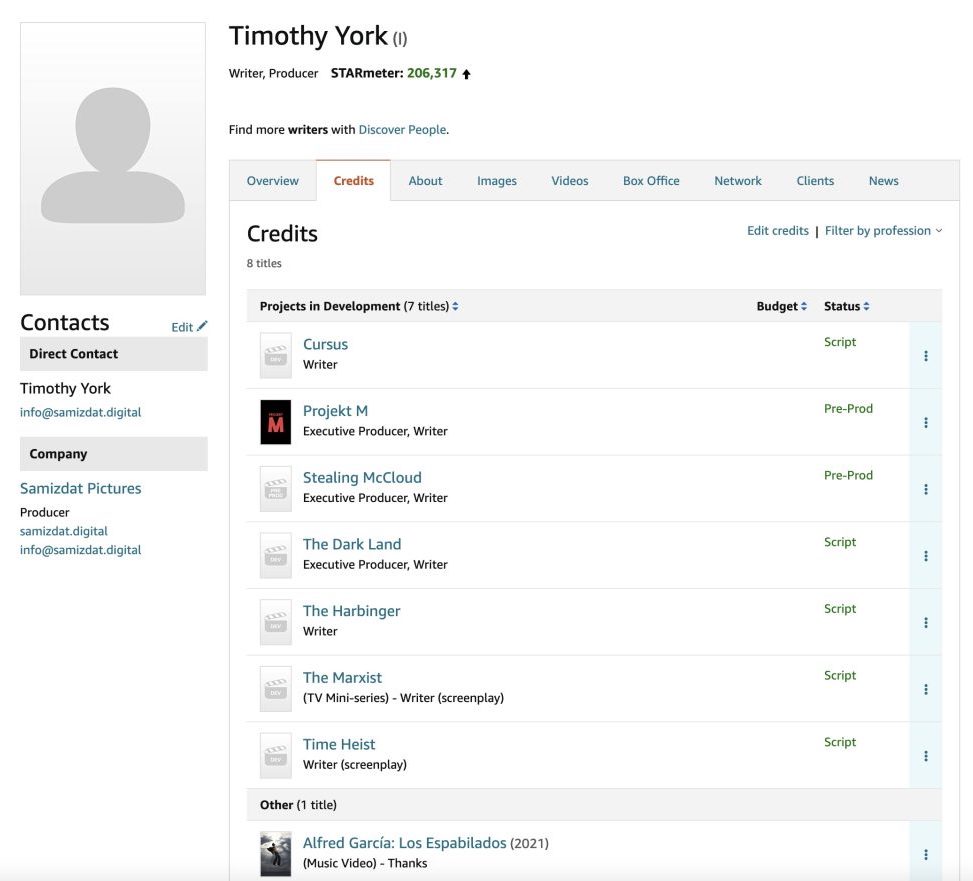
Of course, this story wouldn’t be complete without approaching Brown himself. After months of conversations with his former colleagues and acquaintances, I had lots of questions. I wanted to know whether he looks back on his many transgressions with any sort of remorse; whether he regrets all of the pain he’s caused for so many people along the way; what his motivations were.
And so, in early-to-mid 2023, I made a series of attempts to contact Brown. I sent multiple emails to a total of six, still-active accounts he’s known to have used in recent years. I sent multiple text messages to several phone numbers he’s also used recently. WhatsApp tells me Brown received and read at least some of the messages I sent.
Sadly, all of my attempts to make contact went unanswered, including an email with a long list of the questions I’d hoped to ask him.

Epilogue
There’s a blog post Brown wrote in October 2013 on his Kimmage Fund Refund website entitled, simply, “Statement on Kimmage Fund Controversy”. It’s Brown’s attempt to explain what happened to the fund, why he was holding onto it, and how he was trying to get the money back to donors that requested a refund. In a post full of half-truths and misdirection, one particular section stands out.
“I agreed to take on the responsibility of the fund, to manage the fund, and to ensure right was done with the fund,” he wrote. “I will see through this obligation until the end, no matter what it takes.”
Maybe Brown really meant what he wrote. Maybe he really did want to do the right thing. We’ll probably never know. What we do know, 10 years on, is that whatever his intention, Brown’s grandiose pledge to do the right thing proved to be another empty promise.

Was it his plan from the start to take the Kimmage Fund and disappear? I don’t believe so. I think it’s more likely he saw an opportunity; that through some twisted logic, he was able to convince himself that his claim to the remaining money was as legitimate as anyone else’s. He was the one who “made the Kimmage Fund happen” he told people, even though that wasn’t really true, either.
To me, Brown’s behaviour speaks of desperation; of someone piecing together whatever they can, from wherever they can, however they can. I suspect Brown saw the Kimmage Fund as a gateway to a fresh start; a tantalising chance to put a difficult period of his life behind him.
In his final years in Canada, Brown had been financially crippled by his divorce from Ashton and the child support payments that followed. He couldn’t find a stable job that would get him back on track and neither of his hospitality businesses – San Carlos Caffee nor Wildwood Cafe – offered true financial stability. Indeed, the latter of those cafés left him and Gallardo with a significant tax debt.
Moving to Spain, though, and leaving his financial obligations behind – that would be a fresh start. Doing so with US$70,000 in his pocket? That would be a significant step towards the sort of life he wanted.
To that end: what actually happened to the US$70,000 or so that Brown took from the Kimmage Fund? The most likely explanation also seems to be the most obvious: he spent it. Several people I spoke to recalled Brown and Gallardo living a flashy lifestyle in Girona in the months after they arrived, spending freely and sometimes ostentatiously, despite apparently having little if any work. “He was living a lifestyle he couldn’t afford”, Pickens told journalist Joe Lindsey in 2013.
“I think that he funded the move [from Canada to Spain] with it,” Cohen tells me. “I think that he paid for his security deposit and first and last [month’s rent] on the luxury villa in the Girona Golf estates, on their lease vehicle. They bought stuff for the villa […] they ate out a lot. I think he spent the money.”

I wonder about Brown’s mindset at the time. How did he think he would get away with it? How did he think he could pocket US$70,000 from a charitable fund, flee his homeland where he owed vast sums of money, and not face any repercussions? Did he bank on being out of reach of the authorities as long as he stayed in Spain?
Whatever the explanation, a bizarre truth remains: Aaron Brown did get away with it. Despite a court judgment finding him liable for more than US$100,000, despite a cancelled passport and various debts that would make a return to Canada very difficult, and despite invoking the ire of so many in his orbit over the years, Aaron Brown did somehow manage to squirrel away most of US$70,000 – and keep it, along with thousands more from people who believed in his subsequent ventures – with very few consequences.
As long as Aaron Timothy Brown refuses to speak publicly, his story – and that of the Paul Kimmage Defence Fund – will always feel unresolved. That’s true for those of us that watched it unfold 10 years ago, but I have to imagine it’s equally true for him.
Wherever he goes, whatever he does, Brown’s mishandling of the Kimmage Fund will always be there in the background, looming over him. He can change his name again, reinventing himself over and over, but those around him will learn the truth eventually. Just like those in the wine world did; just like they have in the world of film and TV.
As remarkable as Brown’s story is, it also carries an undercurrent of sadness that’s difficult to ignore. A sadness for all of Brown’s many victims.
Like Lesli Cohen, who put her trust in Brown and ended up losing tens of thousands of dollars and, ultimately, a business she loved. Like Paul Kimmage, who went from feeling the love of a supportive community to needing a Hail Mary just to cover his legal fees. Like the Kimmage Fund donors who trusted that their money would be used as intended, and returned (or donated to charity, as promised) if not required.
The small, family-run wineries in Catalunya who trusted Brown to deliver a documentary he never did. The creatives and entrepreneurs in art and film who were sold dreams by Brown only to have them dashed. The many who were left angry and hurt by even fleeting interactions with Brown. His two families back in Canada.
Maybe one day it will all catch up to him. So far though, Aaron Brown has got away with it all. The only ones paying the price are those he ran into along the way.
Acknowledgments
This story would not have been possible without the generous support of a number of key individuals. Thanks to Lesli Cohen for both her time and for connecting so many dots. Thanks to Iain Treloar for his guidance throughout, both editorial and philosophical, and to Joe Lindsey whose experience and mastery of the craft proved invaluable in the closing stages.
Thanks to Heidi Kimball of Kimball Law for her time and expertise, and to everyone that took the time to tell their stories, whether they appeared in the final version or not.
Finally, a thank you to every single Escape Collective member for their ongoing support. It is your support that allows us to invest the months required to pull together a story like this. If you aren’t an Escape Collective member but you would like to see more stories like this in future, please consider joining. Your support helps more than you know.
Got some more information about the story you’ve just read? Or got a tip about a different story entirely? You can get in touch with Matt via email.
Did we do a good job with this story?
